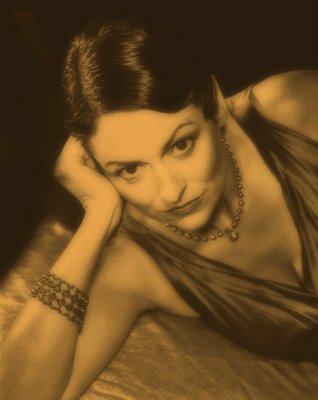
This is another guest blogging contribution by John Lekich.
In the mid-nineties, The Georgia Straight was still making room for extended profiles of worthy local actors. (Unlike rival Vancouver publications who stubbornly refused to consider the possibility of locally nurtured stars in favour of gushing blurbs on visiting Hollywood muscle men.) These deliberately thoughtful ruminations would often include a stunning portrait by Alex. Such was the case when we combined our efforts to reveal the consummate elegance of actor Gabrielle Rose. A devoted Vancouverite who was garnering much critical acclaim at the time thanks to her riveting performance in Atom Egoyan’s The Sweet Hereafter.
Ms. Rose has the distinction of being one of only two actresses whose sheer presence made me blush in the course of an interview. (The other was the great Claire Bloom who Ms. Rose resembles in several ways.) As I recall, she was doing nothing more alluring than eating a slightly undercooked omelet. Still, she managed to prove that refinement, modesty and an unabashed passion for her craft are deeply attractive – if increasingly underrated - qualities. Currently Gabrielle Rose is appearing in the Arts Club production of The Glass Menagerie . Watch as she single-handedly destroys the notion that Vancouver has no stars.
John Lekich, Vancouver
John Lekich Guest Blogger
Tuesday, October 30, 2007
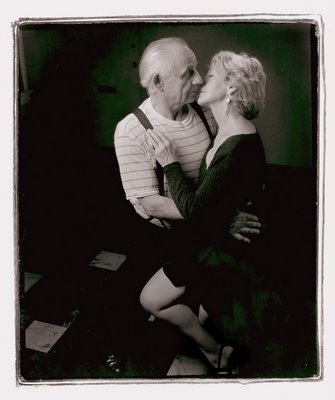
Esa ráfaga, el tango, esa diablura,
Los atareados años desafía;
Hecho de polvo y tiempo, el hombre dura
Menos que la liviana melodía,
El Tango, Jorge Luís Borges, 1964
That I was born in Argentina has never been an advantage in learning to dance the tango. I don't think that tango or football (of the soccer variety) come with the blood. You have to first have the talent. After five years of learning to dance the tango (the Argentine version not the sappy ballroom variety) I realized that all I could say for myself was that I was a competent and efficient tango dancer. In most cases I tried to dance with beautiful dancers so I would not be noticed. That was the case of Indiana who was almost 6 ft tall. She wore long and slinky black dresses with a slit in the right place. Since I am not all that tall I danced comfortably resting my head on her chest. Nobody ever noticed me! All eyes were on Indiana.
That I dance efficiently does not mean that I cannot recognize virtuosity. When I first saw Colin and Iris dance I pictured him as an Austrian violinist in the VSO who moonlighted as a tango dancer. That was not the case. He moonlighted as a nightwatchman and was not Austrian. Iris had these Irish bedroom eyes (well, she had bedroom eyes and happened to be Irish). When these two danced I felt they were dancing in another dimension, but I was given the privilege of looking in. I asked them to come into the studio for some photos. This one was my favourite.
I miss dancing the tango. I miss dancing with Indiana who is a busy mother these days. But I also miss dancing with Iris. There were quite a few men who did not like to dance with her. I soon figured out why. A good female tango dancer has to dance a few microseconds behind the male. She must be in a state of controlled disiquilibrium, ready to follow the male lead in any direction. For me that amounts to driving a car with American-style power steering. You don't get a feel for the road. Iris presented me with a slight resistance (sort of like my Arca Swiss ball/head tripod head). It forced me to slow down. And dancing the tango slowly is what dancing the tango is all about.
When I danced with Iris I felt just a bit over-the-efficient category.
Swimming the Tango
My Father The Tango Dancer
Two Men With A Shoe
Tango Vancouver
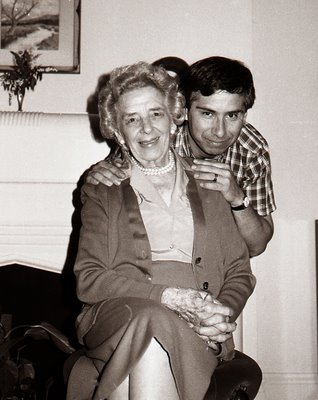
I find that of all the seasons, fall is the one I spend most thinking about. I think about pruning, I think about moving plants, I think about re-arranging flower beds and I think mostly about the growing season being over and wondering if I will be around to enjoy another one. This has nothing to do with me being that old or having some incurable and deadly disease (I am not in that situation that I know of). It has all to do with the acceptance that all good things must end and that includes one's life. At about this time I think of many from my family who are not around or euphemistically, will not see another spring. I think of my aunt, Dorothy Rowstron. And I think of someone whom Aunt Dorothy should have met. Her name is Clare Richards.
Aunt Dorothy, 88, sat in her Sutherland Drive Toronto brick house, beautiful with her Hayward family ( a sister of my father who had four including Dorothy) wavy silver white hair. In her Queen ’s English mixed with Buenos Aires porteño Spanish she said to me, “Alexander, estoy vieja (I’m old) I am in pain all the time. Che, I don’t want to go on.” I was speechless. This came from the person who consumed every Danielle Steel I would bring for her on my yearly trips to Toronto to see magazine art directors. The high point of those trips was the afternoon "té completo” at Aunt Dorothy’s. She insisted that the lemon cake she served me was out of a box and apologized that her tea wasn’t as strong as I liked it. It was all delicious.
Aunt Dorothy’s comment caught me by surprise. I could say nothing. As I waited at the St Clare station for the subway back to town and my Chelsea Hotel I was depressed even though I was on my way to Columbus, Ohio to attend my first hosta convention.
Surrounded by elderly botanical ladies, at a get acquainted dinner at the Columbus Holiday Inn, I was particularly bothered when the two remaining seats were occupied by an old couple. The man who asked me if the seats were taken said, “You are really going to like Robert and Claire Richards, I went to their 50th wedding anniversary last year.” I groaned inwardly. Robert, in his 89s was dressed in one of those multi coloured seer sucker jackets that traveling Americans seem to favour. Clare, 82, very small, looking at me over her glasses, said, in a wonderful Bostonian accent that brought to mind Kennedy’s “Cubar and the missiles” TV speech, “I’m 82 and 4 ft 11 and still shrinking. I have osteoporosis.” I was charmed. For a week we explored hosta gardens. She told me of her garden in Groveland, Massachusetts, and how she had done all the gardening when Robert had gone to war in 1942. She described the statue of St Fiacre in her garden. I was unaware that he was the patron saint of gardening. Clare even managed to give me some pointers on flower arranging. She was renowned for it in Boston. On the last day of the hosta convention I lifted her into her van and kissed her goodby. “Come to Boston one day, my love, and sit in the gazebo (she pronounced it gazaibo) for tea,” she said to me.

In Toronto on my way to Vancouver (too short a layover to see Aunt Dorothy) I bought a Mountie in scarlet postcard and sent it to Clare. Two months later there was no answer from Clare.
A mile out of Columbus, minutes after I had bid them goodbye, Robert and Clare Richards were involved in a head on collision. Both were hospitalized and Clare was in critical condition. I found out because I finally called her.
“Alex," she said,"Today I walked for the first time. They didn’t give me much of a chance. I was in hospital for two months. But I had to get up and walk. I couldn’t allow Robert to do all the weeding. I had to get back to my flower arranging classes. I want to see my Columbus bought plants come up in spring."
I am now 65 years old and it is almost winter. Mortality is often in my thoughts but I think differently thanks to Clare. When she died some five years later after I last received a letter from her I began to discover good reasons for a continued existence. It has to be one spring at a time. As my perennials die back and the garden is put to bed I live in the expectation for what it will do this coming spring. After that it’s not important.
A few months before Aunt Dorothy died; she was 96, I called her up. “Her first question was, “Alexander, there is a new Danielle Steel out. When are you coming to Toronto?”
When she was dead I received a letter from her son-in-law Ivor who told me, “Alex, Aunt Dorothy was a sophisticated reader and she never had the heart to tell you that she never read Danielle Steel. I think you ought to know that.”
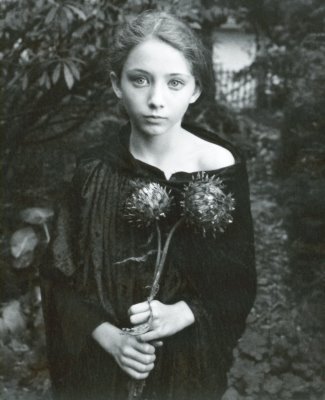
"Moths, and all sorts of ugly creatures," replied Estella, with a glance towards him, "hover about a lighted candle. Can the candle help it?"
Great Expectations, Charles Dickens
This is a Polaroid that I took of Rebecca yesterday in the afternooon in our fall garden. She is holding a couple of dried Cynara cardunculus flowers. She was wearing part of her halloween costume. We began with an ugly black wig and Rebecca posed as some sort of sorcerer. I convinced her to remove the wig and we tried some more pictures. Whe we finished she said, "This has been my favourite shoot ever." I would have corrected her that anytime I can get to photograph her it is my favourite shoot ever.
W.H. Hudson's Little Girls
Stella
More Estella

Esa ráfaga, el tango, esa diablura,
Los atareados años desafía;
Hecho de polvo y tiempo, el hombre dura
Menos que la liviana melodía,
El Tango, Jorge Luís Borges, 1964
That I was born in Argentina has never been an advantage in learning to dance the tango. I don't think that tango or football (of the soccer variety) come with the blood. You have to first have the talent. After five years of learning to dance the tango (the Argentine version not the sappy ballroom variety) I realized that all I could say for myself was that I was a competent and efficient tango dancer. In most cases I tried to dance with beautiful dancers so I would not be noticed. That was the case of Indiana who was almost 6 ft tall. She wore long and slinky black dresses with a slit in the right place. Since I am not all that tall I danced comfortably resting my head on her chest. Nobody ever noticed me! All eyes were on Indiana.
That I dance efficiently does not mean that I cannot recognize virtuosity. When I first saw Colin and Iris dance I pictured him as an Austrian violinist in the VSO who moonlighted as a tango dancer. That was not the case. He moonlighted as a nightwatchman and was not Austrian. Iris had these Irish bedroom eyes (well, she had bedroom eyes and happened to be Irish). When these two danced I felt they were dancing in another dimension, but I was given the privilege of looking in. I asked them to come into the studio for some photos. This one was my favourite.
I miss dancing the tango. I miss dancing with Indiana who is a busy mother these days. But I also miss dancing with Iris. There were quite a few men who did not like to dance with her. I soon figured out why. A good female tango dancer has to dance a few microseconds behind the male. She must be in a state of controlled disiquilibrium, ready to follow the male lead in any direction. For me that amounts to driving a car with American-style power steering. You don't get a feel for the road. Iris presented me with a slight resistance (sort of like my Arca Swiss ball/head tripod head). It forced me to slow down. And dancing the tango slowly is what dancing the tango is all about.
When I danced with Iris I felt just a bit over-the-efficient category.
Swimming the Tango
My Father The Tango Dancer
Two Men With A Shoe
Tango Vancouver
Aunt Dorothy, Danielle Steel & Clare Richards
Monday, October 29, 2007

I find that of all the seasons, fall is the one I spend most thinking about. I think about pruning, I think about moving plants, I think about re-arranging flower beds and I think mostly about the growing season being over and wondering if I will be around to enjoy another one. This has nothing to do with me being that old or having some incurable and deadly disease (I am not in that situation that I know of). It has all to do with the acceptance that all good things must end and that includes one's life. At about this time I think of many from my family who are not around or euphemistically, will not see another spring. I think of my aunt, Dorothy Rowstron. And I think of someone whom Aunt Dorothy should have met. Her name is Clare Richards.
Aunt Dorothy, 88, sat in her Sutherland Drive Toronto brick house, beautiful with her Hayward family ( a sister of my father who had four including Dorothy) wavy silver white hair. In her Queen ’s English mixed with Buenos Aires porteño Spanish she said to me, “Alexander, estoy vieja (I’m old) I am in pain all the time. Che, I don’t want to go on.” I was speechless. This came from the person who consumed every Danielle Steel I would bring for her on my yearly trips to Toronto to see magazine art directors. The high point of those trips was the afternoon "té completo” at Aunt Dorothy’s. She insisted that the lemon cake she served me was out of a box and apologized that her tea wasn’t as strong as I liked it. It was all delicious.
Aunt Dorothy’s comment caught me by surprise. I could say nothing. As I waited at the St Clare station for the subway back to town and my Chelsea Hotel I was depressed even though I was on my way to Columbus, Ohio to attend my first hosta convention.
Surrounded by elderly botanical ladies, at a get acquainted dinner at the Columbus Holiday Inn, I was particularly bothered when the two remaining seats were occupied by an old couple. The man who asked me if the seats were taken said, “You are really going to like Robert and Claire Richards, I went to their 50th wedding anniversary last year.” I groaned inwardly. Robert, in his 89s was dressed in one of those multi coloured seer sucker jackets that traveling Americans seem to favour. Clare, 82, very small, looking at me over her glasses, said, in a wonderful Bostonian accent that brought to mind Kennedy’s “Cubar and the missiles” TV speech, “I’m 82 and 4 ft 11 and still shrinking. I have osteoporosis.” I was charmed. For a week we explored hosta gardens. She told me of her garden in Groveland, Massachusetts, and how she had done all the gardening when Robert had gone to war in 1942. She described the statue of St Fiacre in her garden. I was unaware that he was the patron saint of gardening. Clare even managed to give me some pointers on flower arranging. She was renowned for it in Boston. On the last day of the hosta convention I lifted her into her van and kissed her goodby. “Come to Boston one day, my love, and sit in the gazebo (she pronounced it gazaibo) for tea,” she said to me.

In Toronto on my way to Vancouver (too short a layover to see Aunt Dorothy) I bought a Mountie in scarlet postcard and sent it to Clare. Two months later there was no answer from Clare.
A mile out of Columbus, minutes after I had bid them goodbye, Robert and Clare Richards were involved in a head on collision. Both were hospitalized and Clare was in critical condition. I found out because I finally called her.
“Alex," she said,"Today I walked for the first time. They didn’t give me much of a chance. I was in hospital for two months. But I had to get up and walk. I couldn’t allow Robert to do all the weeding. I had to get back to my flower arranging classes. I want to see my Columbus bought plants come up in spring."
I am now 65 years old and it is almost winter. Mortality is often in my thoughts but I think differently thanks to Clare. When she died some five years later after I last received a letter from her I began to discover good reasons for a continued existence. It has to be one spring at a time. As my perennials die back and the garden is put to bed I live in the expectation for what it will do this coming spring. After that it’s not important.
A few months before Aunt Dorothy died; she was 96, I called her up. “Her first question was, “Alexander, there is a new Danielle Steel out. When are you coming to Toronto?”
When she was dead I received a letter from her son-in-law Ivor who told me, “Alex, Aunt Dorothy was a sophisticated reader and she never had the heart to tell you that she never read Danielle Steel. I think you ought to know that.”
Rebecca Prepares For Halloween
Sunday, October 28, 2007

"Moths, and all sorts of ugly creatures," replied Estella, with a glance towards him, "hover about a lighted candle. Can the candle help it?"
Great Expectations, Charles Dickens
This is a Polaroid that I took of Rebecca yesterday in the afternooon in our fall garden. She is holding a couple of dried Cynara cardunculus flowers. She was wearing part of her halloween costume. We began with an ugly black wig and Rebecca posed as some sort of sorcerer. I convinced her to remove the wig and we tried some more pictures. Whe we finished she said, "This has been my favourite shoot ever." I would have corrected her that anytime I can get to photograph her it is my favourite shoot ever.
W.H. Hudson's Little Girls
Stella
More Estella
Saturday, October 27, 2007
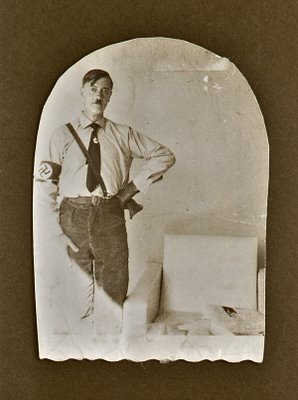
The day before yesterday when I was in my H,I,J files looking for the negatives for Friday's blog I was jolted, as I always am by the file labeled Hitler. And every time I file them away again and conveniently forget about them. I am not even sure these negatives,I copied an original photograph, represent an authentic one. But this blog offers me some sort of justification for showing the picture.
The negatives are in my files because some years ago Jim Christy wrote an article for Vancouver Magazine about Robert George Wilson, who in 1984 had written Confessions of Klaus Barbie , Pulp Press, 1984. Klaus Barbie was known by the epithet, the butcher of Lyon. He wrote it for Vancouver Magazine. I met Wilson and he lent me his Hitler photograph so that it could be reproduced in the Christy piece. Since there were no scanners at the time I had to use a few photographic tricks to make the faded picture look decent.
As I wrote in Evil At The Piano I have that memory of being 6 and being told as I was being combed my mother that I looked like Hitler. A couple of years later I was invited into the house of my friend from across the street on Melián in Buenos Aires. His name was Mario Hertzberg. We called him el alemán , I was el inglesito and our mutual friend Miguelito was el tano as he was Italian). I had no concept of Jews or what being Jewish was all about. In Mario's house I spotted a portrait of a fat Mario on the wall. I smiled and pointed it out to Mario. Mario said, "That is not me. That is my older brother. He died in Auschwitz during the war." I asked how he was killed but Mario never said anything more. It was quite a few years later that it dawned on me what had happened and how the Hertzbergs had somehow survived without that one son (Mario had two much older brothers who lived with him) and moved to Argentina after the war.
Jim Christy
Odd Pattern

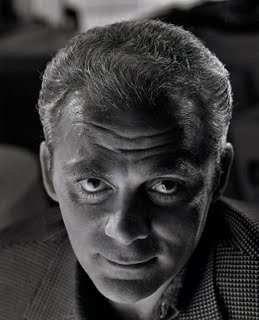
One is an actor the other is a shrewd businessman. Both could play hoods just fine. The actor was smooth and while he only drank Perrier in my presence he wouldn't let go of his Kool mentholated cigarettes. The businessman looked like a hood and spoke like a hood. When I mentioned some of my hood friends from the Ricci, De Cottis and Dal Monte families, their names did not register on his face. He was that good. As it turns out the would-be hood (of my imagination) is a very smart cookie who has made millions for Lion's Gate Entertainment Corporation and helped make our city Hollywood North.
None Nicer
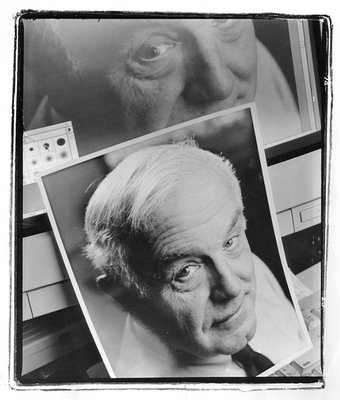
David Hughes was born and educated in England, graduating from Cambridge University with an honours degree in 1957. He entered the emerging commercial computing industry with ICL as a programmer and system analyst. Prior to this he served in the army and reserve army under National Service leaving with the rank of Captain. He emigrated to Vancouver in 1966 and served in management capacities for Canadian General Electric, BC Tel, MIS, the Computer Communications Group, CUE Datawest, and Sierra Systems Group.
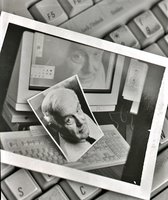
He has wide experience in serving on industry boards as well as advisory boards to government and academia, where he provided a private sector perspective. Mr. Hughes is an avid boater who sailed for many years and now owns a small power boat.
I never quite understood exactly what David Hughes or his company Sierra Systems did at the time that I photographed him for a business magazine. I don't even remember for what magazine it was. I have dates in all the filed envelopes with negatives but this one had no date. I have no tear sheet that includes this photo but I do remember that I took this photos when my knowledge of computers was close to zero. I logged on to the internet in January 1995 but I believe that this photograph is at least 15 years old.
I tell my students at Focalpoint in my perennial class, The Contemporary Nude Portrait, that it is important to photograph the nude to understand what the body does in different positions. With experience and knowledge on how the nude body moves and how limbs flex one can then properly photograph clothed people. It is no different from the training that artists get at art colleges when it is mandatory that they do live drawing.
I went with a straight portrait of David Hughes to my designer friend Ian Bateson and told him what I wanted. Because Bateson, of Baseline Type & Graphics is also an artist and had gone to art college in London, his knowledge on how flesh falls and moves helped him manipulate realistically(Bateson was an early pioneer in the use of Photoshop) my print to make Hughes gaze on himself. I gave the magazine two choices but in the end they used the simpler one seen here, top left.
My friend Grant Simmons (below) at Disc Imaging Group is also very good at Photoshop. I go to him for the printing of my slides as beautiful giclées or for the scanning of slides and negatives to make large prints. He has a light touch and firmly believes, as I do, that just because we can put penguins on a Sahara Desert dune, does not mean we should do it.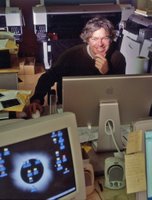
More so than ever photographers have to justify special effects and first satisfy their own personal standards and ethics. My photojournalist friend Nick Didlick once told me, "The only way you can believe the truth of a photograph is not to trust the reputation of the newspaper or magazine. You must know the photographer."
Photographic Misconception Twice
Winner & Loser

The day before yesterday when I was in my H,I,J files looking for the negatives for Friday's blog I was jolted, as I always am by the file labeled Hitler. And every time I file them away again and conveniently forget about them. I am not even sure these negatives,I copied an original photograph, represent an authentic one. But this blog offers me some sort of justification for showing the picture.
The negatives are in my files because some years ago Jim Christy wrote an article for Vancouver Magazine about Robert George Wilson, who in 1984 had written Confessions of Klaus Barbie , Pulp Press, 1984. Klaus Barbie was known by the epithet, the butcher of Lyon. He wrote it for Vancouver Magazine. I met Wilson and he lent me his Hitler photograph so that it could be reproduced in the Christy piece. Since there were no scanners at the time I had to use a few photographic tricks to make the faded picture look decent.
As I wrote in Evil At The Piano I have that memory of being 6 and being told as I was being combed my mother that I looked like Hitler. A couple of years later I was invited into the house of my friend from across the street on Melián in Buenos Aires. His name was Mario Hertzberg. We called him el alemán , I was el inglesito and our mutual friend Miguelito was el tano as he was Italian). I had no concept of Jews or what being Jewish was all about. In Mario's house I spotted a portrait of a fat Mario on the wall. I smiled and pointed it out to Mario. Mario said, "That is not me. That is my older brother. He died in Auschwitz during the war." I asked how he was killed but Mario never said anything more. It was quite a few years later that it dawned on me what had happened and how the Hertzbergs had somehow survived without that one son (Mario had two much older brothers who lived with him) and moved to Argentina after the war.
Jim Christy
Odd Pattern
Dennis & Frank
Friday, October 26, 2007


One is an actor the other is a shrewd businessman. Both could play hoods just fine. The actor was smooth and while he only drank Perrier in my presence he wouldn't let go of his Kool mentholated cigarettes. The businessman looked like a hood and spoke like a hood. When I mentioned some of my hood friends from the Ricci, De Cottis and Dal Monte families, their names did not register on his face. He was that good. As it turns out the would-be hood (of my imagination) is a very smart cookie who has made millions for Lion's Gate Entertainment Corporation and helped make our city Hollywood North.
None Nicer
Penguins In The Sahara & David Hughes
Thursday, October 25, 2007

David Hughes was born and educated in England, graduating from Cambridge University with an honours degree in 1957. He entered the emerging commercial computing industry with ICL as a programmer and system analyst. Prior to this he served in the army and reserve army under National Service leaving with the rank of Captain. He emigrated to Vancouver in 1966 and served in management capacities for Canadian General Electric, BC Tel, MIS, the Computer Communications Group, CUE Datawest, and Sierra Systems Group.

He has wide experience in serving on industry boards as well as advisory boards to government and academia, where he provided a private sector perspective. Mr. Hughes is an avid boater who sailed for many years and now owns a small power boat.
I never quite understood exactly what David Hughes or his company Sierra Systems did at the time that I photographed him for a business magazine. I don't even remember for what magazine it was. I have dates in all the filed envelopes with negatives but this one had no date. I have no tear sheet that includes this photo but I do remember that I took this photos when my knowledge of computers was close to zero. I logged on to the internet in January 1995 but I believe that this photograph is at least 15 years old.
I tell my students at Focalpoint in my perennial class, The Contemporary Nude Portrait, that it is important to photograph the nude to understand what the body does in different positions. With experience and knowledge on how the nude body moves and how limbs flex one can then properly photograph clothed people. It is no different from the training that artists get at art colleges when it is mandatory that they do live drawing.
I went with a straight portrait of David Hughes to my designer friend Ian Bateson and told him what I wanted. Because Bateson, of Baseline Type & Graphics is also an artist and had gone to art college in London, his knowledge on how flesh falls and moves helped him manipulate realistically(Bateson was an early pioneer in the use of Photoshop) my print to make Hughes gaze on himself. I gave the magazine two choices but in the end they used the simpler one seen here, top left.
My friend Grant Simmons (below) at Disc Imaging Group is also very good at Photoshop. I go to him for the printing of my slides as beautiful giclées or for the scanning of slides and negatives to make large prints. He has a light touch and firmly believes, as I do, that just because we can put penguins on a Sahara Desert dune, does not mean we should do it.

More so than ever photographers have to justify special effects and first satisfy their own personal standards and ethics. My photojournalist friend Nick Didlick once told me, "The only way you can believe the truth of a photograph is not to trust the reputation of the newspaper or magazine. You must know the photographer."
Photographic Misconception Twice
Winner & Loser
Wednesday, October 24, 2007

My Norman 200B is so important in my photographic life that I have three of them. All three are at least 25 years old or more. There are all kinds of stories that photographers tell (or at least they used to tell when there were enough of them for a friendly beer quorum) about being in the middle of Alberta on an annual report (when forestry companies were rich enough to have annual reports). They recount of a sudden loss of power in mid shoot of one's rented studio lights. What to do? And then the photographer remembers that there is a little case in the car, or back in the hotel with a Norman 200B. Salvation is at hand and the assignment is successfully finished. Which proves that a small light can go places if it works all the time.
My Norman 200B (actually a pair of them in a metal photo case) has come to the rescue. In May I broke my left elbow. I have been unable to stretch out my left arm completely. My therapist measures the angle by subtracting from 180 degrees. A month and a half ago I was at 27 degrees. With Torquemada type techniques they got that down to 22. But now Maureen my therapist at VGH is measuring 18 and 17 with her special protractor. She looks at me and smiles, "Norman is helping lots." For the last month I have been walking around the block twice a day and wherever I go I carry my metal case containing the two Normans. Maureen suspects that intermittent exercise makes no difference if measured in minutes. But walking with the Normans over longer periods of time is making that difference.
The average person seeing the picture here, that I took of Rebecca in Rosemary's kitchen garden in August, would not suspect that I used an artificial light. But I did. It is lit by a Norman 200B inside a 3x4 ft softbox (it's like a tent) and the sun while present was playing second fiddle.
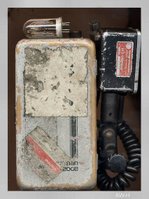
I never became an engineer because I failed electricity in university. My bête noire was my inability to differentiate among resistance, inductance and capacitance. Little I was to know then that some day I would come to understand exactly what capacitance is all about and that what makes my Normans great battery-powered flashes is that they have dependably tough capacitors.

My Norman 200B is so important in my photographic life that I have three of them. All three are at least 25 years old or more. There are all kinds of stories that photographers tell (or at least they used to tell when there were enough of them for a friendly beer quorum) about being in the middle of Alberta on an annual report (when forestry companies were rich enough to have annual reports). They recount of a sudden loss of power in mid shoot of one's rented studio lights. What to do? And then the photographer remembers that there is a little case in the car, or back in the hotel with a Norman 200B. Salvation is at hand and the assignment is successfully finished. Which proves that a small light can go places if it works all the time.
My Norman 200B (actually a pair of them in a metal photo case) has come to the rescue. In May I broke my left elbow. I have been unable to stretch out my left arm completely. My therapist measures the angle by subtracting from 180 degrees. A month and a half ago I was at 27 degrees. With Torquemada type techniques they got that down to 22. But now Maureen my therapist at VGH is measuring 18 and 17 with her special protractor. She looks at me and smiles, "Norman is helping lots." For the last month I have been walking around the block twice a day and wherever I go I carry my metal case containing the two Normans. Maureen suspects that intermittent exercise makes no difference if measured in minutes. But walking with the Normans over longer periods of time is making that difference.
The average person seeing the picture here, that I took of Rebecca in Rosemary's kitchen garden in August, would not suspect that I used an artificial light. But I did. It is lit by a Norman 200B inside a 3x4 ft softbox (it's like a tent) and the sun while present was playing second fiddle.

I never became an engineer because I failed electricity in university. My bête noire was my inability to differentiate among resistance, inductance and capacitance. Little I was to know then that some day I would come to understand exactly what capacitance is all about and that what makes my Normans great battery-powered flashes is that they have dependably tough capacitors.
Tuesday, October 23, 2007
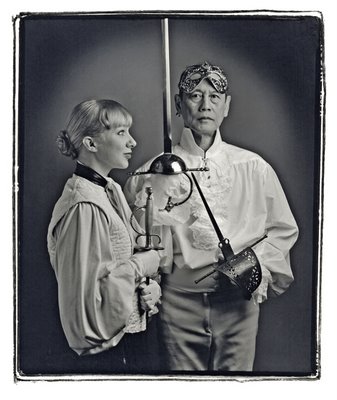
Cambodian-born fencing master, Maítre Bac Tau begen his career in 1965 with his Diplôme de Moniteur d'Escrime, from the Ligne de L'Académie d'Armes de Paris. Not only did Maítre Bac show talent but the head of the academy warmed to the young man, telling him, "My father taught your King, Nordom Sihaneuk, to fence." (Sihaneuk was better-known as a trombone player).
Maítre Bac, a member of the Coaching Commission of the Academie d'Armes Internationale, has written books on fencing, from the classic The Fundamental Principles and Techniques of Foil (1985) to a useful The Manual for the Care and Repair of Electric Fencing Equipment(1996). He is central to the Vancouver fencing scene.
As serious as this might be, fencers never forget their childhood roots. And they do so with a smile. Maítre Bac confessed that when he was six he cut his first bamboo stick so he could play Zorro. He agrees that the longest and best scene in the movies is in Scaramouche, in which the dashing Stewart Granger, in full Technicolor vanquishes Mel Ferrer at the Paris Opera. Maítre Ba cites The Fencing Master, a 1993 Spanish film based on Arturo Pérez-Reverte's novel El Maestro de Esgrima as the most authentic.
Why is Maítre Bac's 18-year-old-pupil, Maja Futrell-Frühling smiling in the photograph? The aspiring actress says it is great for an actor to have the ability to fence. With a smile she said, "Besides being a sport, you get to poke people with a swords, it is good stress relief." An ideal pursuit for anyone who, as it says in the opening line from Rafael Sabatini's Scaramouche, "was born with a gift of laughter and a sense that the world was mad."
The above appeared originally in the July 2007 issue of Vancouver Lifestyles Magazine.
Swashbucklers
More

Cambodian-born fencing master, Maítre Bac Tau begen his career in 1965 with his Diplôme de Moniteur d'Escrime, from the Ligne de L'Académie d'Armes de Paris. Not only did Maítre Bac show talent but the head of the academy warmed to the young man, telling him, "My father taught your King, Nordom Sihaneuk, to fence." (Sihaneuk was better-known as a trombone player).
Maítre Bac, a member of the Coaching Commission of the Academie d'Armes Internationale, has written books on fencing, from the classic The Fundamental Principles and Techniques of Foil (1985) to a useful The Manual for the Care and Repair of Electric Fencing Equipment(1996). He is central to the Vancouver fencing scene.
As serious as this might be, fencers never forget their childhood roots. And they do so with a smile. Maítre Bac confessed that when he was six he cut his first bamboo stick so he could play Zorro. He agrees that the longest and best scene in the movies is in Scaramouche, in which the dashing Stewart Granger, in full Technicolor vanquishes Mel Ferrer at the Paris Opera. Maítre Ba cites The Fencing Master, a 1993 Spanish film based on Arturo Pérez-Reverte's novel El Maestro de Esgrima as the most authentic.
Why is Maítre Bac's 18-year-old-pupil, Maja Futrell-Frühling smiling in the photograph? The aspiring actress says it is great for an actor to have the ability to fence. With a smile she said, "Besides being a sport, you get to poke people with a swords, it is good stress relief." An ideal pursuit for anyone who, as it says in the opening line from Rafael Sabatini's Scaramouche, "was born with a gift of laughter and a sense that the world was mad."
The above appeared originally in the July 2007 issue of Vancouver Lifestyles Magazine.
Swashbucklers
More
Monday, October 22, 2007

The gloom of the fall rain and the promise of the winter cold are wonderfully compensated by the warmth of going to listen to my friends play music. My friends (incuding violinist/violist Paul Luchkow, below) are the musicians of the Pacific Baroque Orchestra.
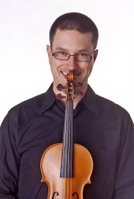
They play baroque music standing up (read below) very close to where I sit in the protective and intimate environment of a church. They perform music that is rarely played on the radio. It is fresh, exciting, challenging and satisfying. I often attend with my friends Graham Walker, Abraham Rogatnick and my granddaughter Rebecca.
-----------------------------------------------------------------------------------------------------
Delirio Amoroso: Handel's Italian Years
Alex Weimann - Guest Director
Washington McClain - Oboe Soloist
Saturday, October 27, 2007, 8.00 p.m.
St. Augustine's Church, Vancouver
2028 West 7th Avenue (corner of Maple and West 7th)
Sunday, October 28, 2007, 2.30 p.m.
West Vancouver United Church
2062 Esquimalt Avenue (at 21st Street and Marine Drive)
----------------------------------------------------------------------------------------------------------------------------------
In September 2002 the Pacific Baroque Orchestra, my favourite Canadian orchestra, and its leader, violinist Marc Destrubé introduced their first CD with the Haydn violin concertos in G, C and A major. The CD cover photo of Destrubé was my last contribution as a two-year trustee of the orchestra.
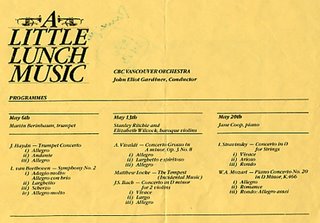
My journey into an intimate musical enlightenment began while munching on a bag of fish and chips (with my daughters Ale and Hilary) on May 13, 1980 at the Orpheum Theater in Vancouver. John Eliot Gardiner (seen here in CBC's Studio 1 where I photographed him in 1979) was directing the CBC Vancouver Orchestra in a series called A Little Lunch Music. The program featured Bach’s concerto in D minor for 2 violins.
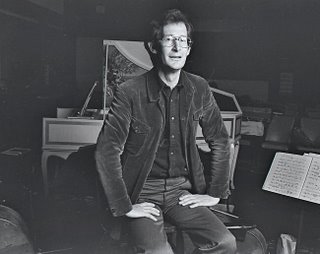
That year Gardiner had begun to verse the ensemble in baroque performance practice, and had introduced period bows and tuning. At the concert Gardiner showed us the difference in sound between the modern and baroque violins. I was hooked to the latter’s quieter but warmer sound.
On Sunday October 27, 1996 at Ryerson Church in Vancouver. A local baroque group founded in 1990, the Pacific Baroque Orchestra, played the Vivaldi Gloria in D major RV 589. The concert not only opened my ears but also my eyes. The musicians, with the exception of the cellists, the bassist and the harpsichordist, to my consternation, were all playing standing up. The big surprise was the all female Electra Women’s Chorus. I had never heard a Vivaldi Gloria with an all female chorus. The performance introduced me to red-haired sisters Caitlin (a mezzo soprano) and Phoebe MacRae (a soprano) who were featured soloists. In later years I would enjoy hearing Caitlin with Vancouver’s Musica Intima and Phoebe as a frequent soloist with the PBO and with the Modern Baroque Opera (now sadly gone).
Soon I found myself going to all the performances of the PBO. I was particularly attracted to sitting in the front rows and hearing the group playing in intimate concert venues, usually churches. It was a surprise to me when two years ago I was called by PBO manager Tom Durrie called me to ask me to be a trustee. My wife suggested that this could be a good career move for me. A more cynical member of the Vancouver Symphony, pianist Linda Lee Thomas told me, “It’s for free pictures, and you’re a photographer.”
My wife was wrong, I spent too much time worrying about the finances of the PBO and little on our own. While I did provide the PBO with free pictures the two-year experience was rewarding and an eye opener in many ways.
I had erroneously thought that as a trustee I would get to see all the concerts for free. No, I had to pay. I thought that being a trustee would be a prestigious endeavor I could boast about. In a city where the arts are suffering what some call a “fund raising burnout” I found I had to help organize golf tournaments. I hate golf. Who would ever know that one of the problems was to find someone who would transport the harpsichord to a concert?
For a while my media connections served me well. When countertenor Matthew White was to appear at a concert with the PBO I called up CBC Radio’s Paul Grant and offered to take to his studio a grown man who sang in a falsetto. The subsequent interview helped fill seats. But soon calling my friend Vancouver Sun music critic Lloyd Dykk put me into the dilemma: was I wearing the hat of friend or of PBO trustee wanting exposure for the band?
As a trustee I found out the nightmarish financial problems that most arts organizations are in. Budgets include federal, provincial and city grants that are not always sure things. Not getting a grant can spell an operating disaster which fund-raising events can only partially alleviate.
After two years as a trustee I feel that the closer contact I had with musicians (many showed up at the board meetings) has given me a further insight into music, baroque music and how it is played.

From Destrubé I found out that until Ludwig Spohr invented the violin’s chin rest emotion in music was heard through the composer’s music. “Once the chin rest was there,” Destrubé said, “ the music could be heard in the musician’s head. We could now feel the music and express ourselves through it.” He further explained that the French Revolution marked the decline of rich patrons for music and composers and musicians had to rely on ordinary citizens to foot the bills. This meant larger concert halls where instruments had to be louder. Baroque instruments were beefed up to allow for strings under higher tension. The warmth of the baroque instruments was superseded by the need for a louder sound.
While being a trustee did not, in the end make me feel important, I have learned that sitting up front at a PBO concert is no different from being a king of a European country of the 18th century. These musicians are there, close, playing just for me.
And why do members of the PBO play standing up? Marc Destrubé explained, “Just like rock and roll musicians connect with their audience by standing, I feel we can, too."
PBO
More PBO
And even more PBO
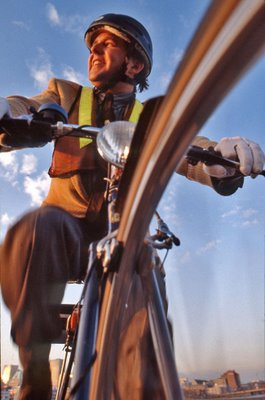
Yesterday Rebecca, Lauren, Rosemary and I watched Alexander Korda's wonderful 1942 film The Jungle Book with Sabu. I particularly thought it appropriate for Rebecca as I wanted her to see the Kipling classic in a film with real people and real animals. I didn't want it to be an animated film. Rebecca liked it (even though Sabu kills Shere Khan and does not run away as in the PC Disney film) and wasn't too sure if the crocodile was real all the time. "Perhaps it was a trained crocodile," she said. Later in the evening she was watching a terrible film with Terrence Stamp (the villain) and Eddie Murphy (the hero). It had lots of special effects and swordplay and levitations. The contrast between the films made me think of the concept of special effects. In The Jungle Book the special effects consisted in trying to make a Hollywood lot look like an Indian jungle. The war made it impossible to shoot it on location. In the 90s I was well known for photographic special effects in the magazine business, before Photoshop brought us penguins in the Sahara.
There was one special effects photograph I had taken but I could not remember the name of my subject until I found the old Vancouver Magazine tear sheet from May 1990 yesterday. It had been one of those Sean Rossiter 12th & Cambie columns, this one called The Pedal Pushers. It was a column that was well ahead of its time as it told the story of Nelson McLachlan who, to quote Rossiter:
Nelson McLachlan was sitting in his snazzy new metallic brown 1982 Toyota Cellica fastback, idling in the lat-afternoon traffic jam at 41st and Granville, when he had one of those almost religious experiences that occur to all of us but get forgotten by the time we find a parking spot. Barely 22 years old, still paying inflation-era interest on his car loan although the economy was in a freezer, McLachlan suddenly saw that he was working full time for no other reason than to make the payments of his car.
This is crazy, he thought. He pulled into Granville Toyota (at 41st), quickly agreed to accept $7,500 cash for the Celica - it needed vacuuming - and took the Number 3 Road Richmond Express, home to the 18-speed, custom frame bike that had cost him $1000.
Rossiter wrote on how McLachlan became chair of the city's Bicycle Advisory Committee and spearheaded making it mandatory for downtown office developers to build bike racks and changing facilities. The article was airing the problem of the fact that cyclists could not ride the SeaBus and buses had no bike racks. In short McLachlan probably helped a lot in making Vancouver an almost bike friendly city. I wonder where he is now and is he still cycling down from Richmond to Vancouver?
For the photograph I wanted to do something sharply different from the usual panned shot of a sharp cyclist with a blurred background. I attached a Nikon FM-2 with a fisheye lens and a motor drive to the front hub of McLachlan's bike tire by using a then (and now) legendary Manfrotto Super Clamp.

This clamp can bind firmly anything to anything. I had to trust the clamp not to fail as expensive equipment would have literally bitten the dust. I wrapped a remote motor drive button (in the picture here you can see glimpses, on the left side of the picture on the handle bar) and told McLachlan to drive back and forth (but take pictures only on the side that had sun on his face. We shoot three rolls of 36 exposures. Art director Rick Staehling chose this one for the spread and we had a massive argument.
It has always been my belief that whoever presses the shutter of a camera is the person who takes the picture. I told Staehling that the photograph had to be photocredited to McLachlan. We finally compromised on a joint credit.
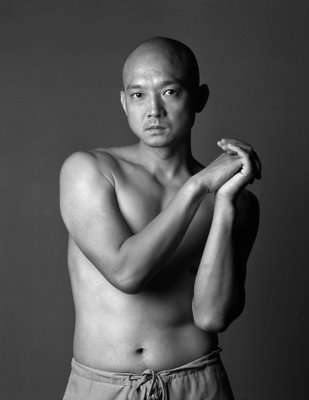
There is one book in my library that I have never finished. It is Russel Hoban's 1980 Riddley Walker. It is an apocalyptic novel much like my favourite A Canticle for Leibowitz but I cannot struggle past chapter one. Hoban invented a language for the main protagonist Riddley who speaks in a devolved form of English, with a much changed spelling and resembles a phonetic transliteration of a Kentish accent. I have given up on this book. Riddley Walker is defined as an ergodic novel. An ergodic novel requires a "non-trivial effort" to traverse the text. This effort must be extranoematic, that is, it must consist of more than simply reading by moving one's eyes along lines of text, turning pages and mentally interpreting what one reads. My favourite José Saramago, who is very stingy with punctuation, is a mild example of ergodic literature.
Sitting on the front row with Rebecca last night at the Cultch watching the hour long dance program, Three Sixty Five by choreographer Wen Wei Wang was sort of like ergodic dance if there is such a thing! The music was composed by Giorgio Magnanensi and the score was pre-recorded with the addition of the never boring and very live cello of Peggy Lee. The music seemed to me like a devolved Four Seasons by Antonio Vivaldi. And there was a reason for this. Wen Wei Wang says this in his choreographer's statement:
After four years of work with my own company I wanted to challenge myself as a creator and push myself beyond my own cultural roots. Vivaldi's Four Seasons was my inspiration for this work and is also the basis for Giorgio Magnanensi's composition. This has been a great challenge for me. Vivaldi's music is so beautiful, so well known and so often chosen by choreographers that it required a fresh and imaginative treatment in order to succeed. This project was not just to create new movement but a way for me to understand another culture through its music.
My last work, Unbound, was the result of my proceeding choreographies and I regard Three Sixty Five as the beginning of an important new phase in my choreographic career. As I enter this phase I want to go beyond everything I have previously expressed through movement.
-Wen Wei Wang
I relied on my own imagination to figure out this one hour long dance that pushed the five dancers with constant and grueling movement to the limit of their abilities. Five dancers (sparingly dressed in white) and one musician (Peggy Lee), a troupe of entertainers in a space ship from Proxima Centauri on their way to Sirius get lost and crash land on our planet. We have been gone for a while. In a dump site Lee finds a boom box with a tape (Vivaldi's Four Seasons). Radioactivity and age have affected both the tape and the box. What plays (every once in a while you can recognize Vivaldi, the rest of the time it seems to sound like program music)is the score we heard last night.
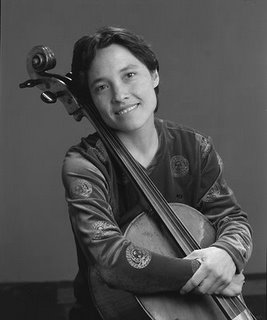
Lee puts in her interpretation and the dancers do likewise. I felt both trapped and mesmerized by the performance. A white violin hangs from the ceiling. The dancers and the musician have discovered a cult to the instrument. They are in awe of it.
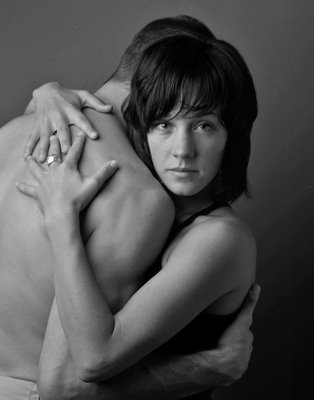
And so were we in awe of the five dancers, Wen Wei Wang (slippery and fit like a Weddell Sea seal), Scott Augustine (a prime example of this new breed of Vancouver contemporary dancers who are compact and with their low centre of gravity can move with incredible speed) Karissa Barry (when I saw her in the mentor program at Arts Umbrella she already stood out. She is another one of those compact and strong dancers) Andrea Keevil (willowy in contrast to the rest) and lastly Alison Denham. Of Denham, Rebecca said, with amazement, "What abs!" Unlike Hoban's Riddley Walker I think I could handle Three Sixty Five one more time.
There is one more performance of Wen Wei Wang's Three Sixty Five tonight at the Vancouver East Cultural Centre.
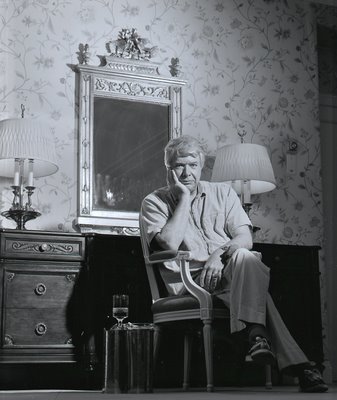
Rosemary and I attended the opening on Wednesday evening of the Daniel MacIvor play His Greatness based on a potentially true story about two days in 1980 (in a Vancouver hotel room) in the last years of the life of Tennessee Williams. He died in a New York hotel in 1983. The play (on until November 10 at the Granville Island Stage of the Arts Club Theatre Company) is superbly played by Allan Gray, David Marr and Charles Christien Gallant. Alas I never had the opportunity to photograph any of them so others are posted here as surrogates.
Rosemary, my wife, rarely likes anything but on Wednesday night she was smiling with pleasure and glee.
Yes, I laughed a lot, particularly when playwright MacIvor made fun of our two-newspaper town. But I was dead serious and uncomfortable (paradoxically) because of the uncanny reconstruction by Scenery Director Kevin McAllister and Lighting Designer Alan Brodie of what to me has to be a Hotel Vancouver suite. I should know as I have photographed many actors, politicians, directors, authors, pornography stars, etc in many Vancouver hotels and quite a few of them at the Hotel Vancouver.
One of my first Hotel Vancouver subjects and, certainly one that gave me lots of pleasure was a sitting with poet/novelist Timothy Findley in October 1988. While I was certainly no Young Man, played with a wicked panache by Charles Christien Gallant, I was the younger and third person in that Hotel Vancouver suite. The second was Findley's friend Bill Whitehead. At the time I discussed with the friendly Findley ("Please call me Tiffy.") the idea of some day having a show of hotel portaits. In January 1989 I received a kind letter from Findley that raised the question of those hotel portaits.
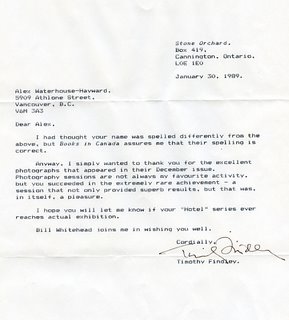
I wonder if anybody snapped His Greatness when he was in Vancouver? I must state that I first became interested in taking photographs in Vancouver hotel rooms when I saw the picture (seen here) of Mark Twain holding court from his bed in the (yes!) Hotel Vancouver when he visited our city on August 18, 1895.
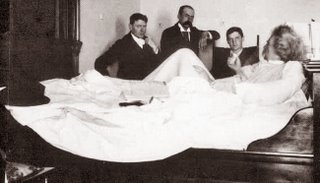
I include here a photograph of American writer Richard Ford whom I photographed at the Hotel Vancouver in October, 1990. He had come to town for the Writer's Festival. I had taken the liberty of calling the Hotel Vancouver publicist to tell her that of all the persons who were staying at the hotel the one who would most likely write about the hotel was British travel writer (by then he had moved to Seattle) Jonathan Raban. I did not know that Raban and Ford were friends. While I was taking Ford's picture (I'm happy," he said to me, "you are making me look like Graham Greene."), Jonathan Raban walked in and said, "Richard I have this great big room that is semicircular and occupies a whole end of the hotel. I have no idea why I have been given this room." Ford countered with, "Mine is a normal room. Somebody must like you." I said nothing.
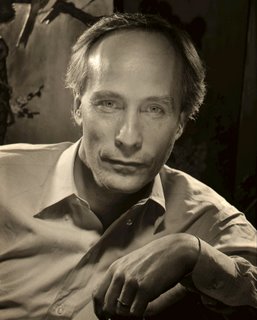
Rosemary and I drove home from His Greatness. We were silent but content. After all it had been an excellent evening at the theatre. While I had missed Tennessee Williams's stay in Vancouver, the play had carried me back to that hotel room in my head, haunted by all those ghosts, some dead some alive that have passed in front of my camera and through my life.
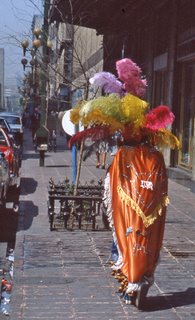
In 1995 when I read Mexican poet and novelist Homero Aridjis's novel ¿En quien piensas cuando haces el amor?, I was perplexed by the mention of a Vivaldi opera called Motezuma. I figured this was simply a sample of Homero Aridjis's brand of Magic Realism. This was not the case. When I interviewed him at his Mexico City home in 1997 he said it was a long lost opera.
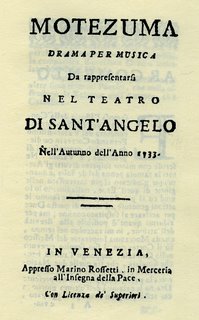
He also told me that what was most interesting is that in the premiere in 1773, Vivaldi's mistress Anna Giró had played the lead female part. Aridjis said he had first read about the opera in an Alejo Carpentier novel. When I returned to Vancouver I went on an Alejo Carpentier binge taking out most of his books from the excellent collection at the UBC Library. It was there that I discovered Carpentier's novella Concierto Barroco.
I don't know why but in the middle of the night, last night, and the reason for this blog today, I dreamt of a character (above) I had photographed near the Zócalo (Mexico City's main square) in 1997. I never saw his face as he walked quickly away in his colourful indian clothing. He and a musician I photographed a few blocks away, made me remember my favourite Arijdis poem that conjures the ghosts of people from the past mingling with us. Was that man Moctezuma's ghost? Or could it have been the Grand-Tour-Mexican dressed as Moctezuma (read below) come back to Mexico aftr his binge in Venice?
"Invisible ancestors
walk with us
through the back streets
car-noises
the stares of children
young girls's bodies
cross through them
Weightless and vague
we travel through them
at doorways that no longer are
on bridges that are empty
with the sun on our faces
we too
move toward transparency." Homero Aridjis - Letter From Mexico
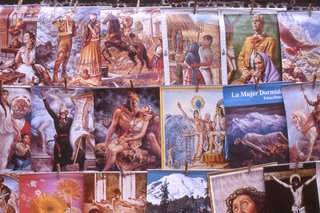
Moctezuma was first portrayed on the stage in 1695 in Henry Purcell’s masque The Indian Queen. Purcell got it wrong as Montezuma is seen as a young Inca general in the Peruvian army. Jean Philippe Ramaeu’s lncan setting in Les Indes Galantes is now thought to be the first serious work on the new world set to music. The fact is that two years before, in the autumn of 1733, Antonio Vivaldi premiered his first opera, Motezuma in the Teatro Di Sant’Angelo with a libretto by Alvisi Giusti. Anna Giró, Vivaldi’s supposed mistress, sang the lead female part. A meeting between Vivaldi, Handel and Domenico Scarlatti (who had been seent by his father Alessandro to seek his musical fortune in Venice) during the Christmas carnival in Venice in 1709, by all accounts had no bearing with Vivaldi’s opera Motezuma.
But Cuban born writer Alejo Carpentier (1904-1980), who coined the term lo real maravilloso or “magic realism”, thought otherwise.
In his 1974 short novel Concierto Barroco (the same title in the English translation available at the Vancouver Public Library and at the UBC Library in Spanish) a bored rich Mexican goes on a grand tour of Europe with Filomeno, black Cuban servant who has a fondness for women and trumpets. Bored in Madrid, the Mexican ends up in the Venice carnival in 1709. Dressed as Moctezuma, (his black servant, decides that his face will do as a mask) runs into the composers, all three very drunk, in a dark corner of Victorio Arduino’s Botteghe di Caffe. The idea for the opera is born when Vivaldi questions the Mexican on his costume. That Vivaldi doesn’t get the story quite right (or the name as any Mexican who knows history will tell you it's Moctezuma not Montezuma or Motezuma) could be blamed on his inebriated state.
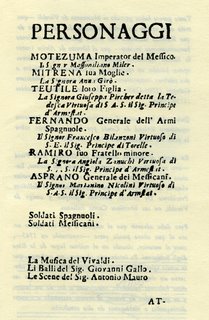
What follows is one of the most delightful stories I have ever read. An impromptu concert with the composers and Vivaldi’s foundlings ( with the wonderful names, Pierina del violino, Cattarina del cornetto, Guiseppina del chitarrone, etc…..) at the Ospedale della Pieta, leads into a session with Louis Armstrong charming Handel and the Cuban servant with his rendition of I Can’t Give You Anything But Love.
It should come as no surprise to those who may have read other books by Carpentier, an eminent music critic and musicologist, that in Concierto Barroco he uses this knowledge to play jokes and twist time, while educating us. The Mexican and the composers have a picnic on Igor Stravinsky’s tomb, who some credit with having said, “Vivaldi wrote the same concerto 600 times.” Thus we find out that Stravinsky is buried In Venice (but did not die there) while another character in the novel, Richard Wagner in a casket, died but is not buried in Venice.
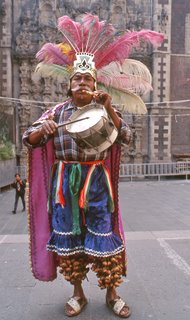
If Concierto Barroco is a literary potato chip that has you wanting more I would recommend Jose Saramago’s Baltasar and Blimunda wherein Domenico Scarlatti plays the harpsichord in early 18th century Portugal while the novel’s heroes Baltasar and Blimunda build a flying machine.
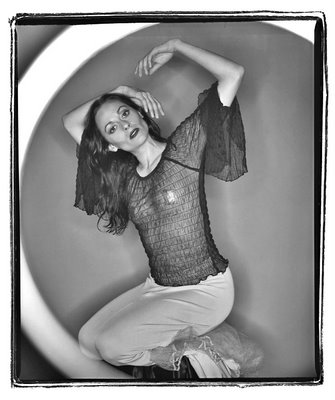
I receive email announcements from Vancouver arts publicists. This profession in Vancouver is as endangered as the Stanley Park penguins. So I would never, ever call it spam. These publicists need all the help we can give them. As an example why would anybody leave home on a lazy late October or November afternoon? This is the announcement that I received from the Museum of Anthropology, admission is $9.00, $7.00 for seniors and students.
Stimulating the Senses: A Sunday Series of Music and Movement
Kokoro Dance: “Heart, Mind, Spirit, & Soul”
Sunday, October 28, 2007, 3:00 pm
Kokoro Dance merges kinetic and visual elements from Japan and the West to create a uniquely Canadian Butoh aesthetic. This concert is presented as the second in our Sunday series of three dance and music performances, “Stimulating the Senses: Music and Movement at MOA.”
“Move It!” – Joe Ink
Sunday, November 18, 2007, 3:00 pm
“Move It! is everybody’s chance to groove. Find your feet in the participatory workshop with Tara Cheyenne Friedenberg and Jacci Collins.
--------------------------------------------------------------------------------------------------------------------------------
I don't think I have ever seen Jacci Collins but I can tell you plenty about Kokoro and Tara Cheyenne (who now includes her married name. Damn!) Friedenberg.
Of Kokoro (that's Jay Hirabayashi and Barbara Bourget below, left) I already wrote here but I have never told you about Tara Cheyenne.
I first photographed her in my studio for the Georgia Straight and she told me she was going to appear in one of the Dances for a Small Stage. She told me she was going to be a mermaid. She didn't come with the costume to my studio but we made do. Since the Straight is a family publication she offered to tape her nipples. They showed in my Polaroids. We used gaffer tape!
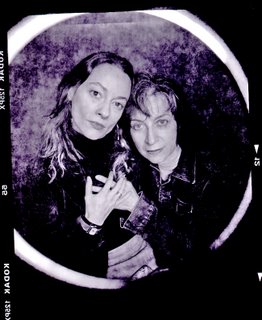
Dancing at Dances for a Small Stage is a challenge as the stage is small. But I was not prepared to see what I saw. Cheyenne sort of splashed on stage and stayed in one spot. Can mermaids dance? She made seal noises and moved her upper body in amazing sinuous movements. Since then I have been amazed by her virtuosity.
Now there is a recently retired choreographer of note, Chick Snipper (of Slab fame, seen here with Cheyenne, right) who also noted her virtuosity. Upon retiring, Snipper handed over her company to Cheyenne.
A few days back at Stupidity I ran into Cheyenne. I can report (and if you cannot justifiably describe the body of a dancer then what's left?) that she looks even more voluptuous than I remember her and I see many reasons why we should leave the comfort of our home on a lazy (and probably bleak) Sunday, November 18 afternoon.
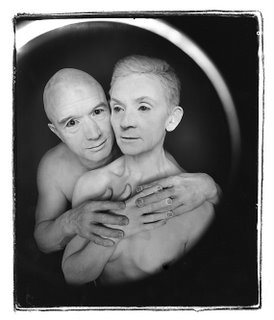
And what of the other Sunday, October 28 afternoon with Kokoro Dance? If you have never ever seen Butoh here is your chance to see this Japanese 20th century dance form inside a perfect venue, Arthur Erickson's Museum of Anthropology.
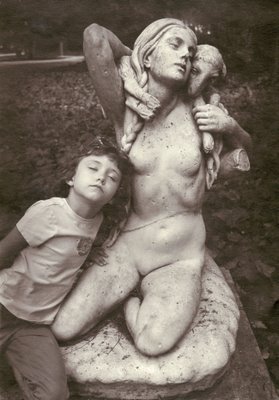
This photograph has appeared before here but it is constantly before me as I go up and down the stairs to and from our bedroom. It hangs outside the bedroom hall. It is impossible to miss. It is special in many ways, the least of which, is the easiest to explain.
I cannot do justice to the print here. I scanned the framed photograph and the glass added some green I had to remove. The print is one of six pictures of Rebecca that I made from a found envelope of Agfa Portriga that was hiding in a dark corner of my darkoom. The paper was long discontinued by Agfa and Agfa is now gone. The paper was very special as it had a rich warmish tone that produced what is called split toning when I immersed the fixed and washed print in a very strong solution of selenium. Because the paper was expired it developed a few extra colours of its own which can never be duplicated.
And of course I can never duplicate the moment or the experience of snapping this picture of Rebecca in the Buenos Aires Botanical Garden. The garden is known for its varied and rich sculpture, its cats (hundreds of stray cats and left cats) and for a fading glory of plants that with no budget have to manage on their own.
It was perhaps here (in that garden) where the Vancouver-born Rebecca developed that air of sophistication that I hope will never leave her. I further hope she will inherit my mother's flair. She always used to tell me, "Alex, hay poca gente fina como nosotros." There are few people as sophisticated (Spanish fina or fino is a combination of gentle manners, too) as we are."
Last week our neighbourhood had an art show at the nearby Osler Elementary gym.
It was an evening affair with wonderful food and sweets. I brought 11 pictures of Rebecca. But because we were told to think of the venue (children) I knew I would have had a problem if I had taken this, the finest of all the pictures of Rebecca along. I didn't.

It was when Rebecca was 6, a few months before we went to Buenos Aires four years ago that I took Rebecca to the Calabria Bar on Commercial. We sat right under a reproduction of Michelangelo's David. Rebecca asked the obvious question and I explained why it was sculptors favoured the nude. It has been one of our favourite places for cappuccino in the city. Rebecca calls the table under David, "Our table." Shortly after, one afternoon of sipping mate and chatting Spanish with Juan Manuel Sanchez and Nora Patrich, Rebecca and I returned home. She decided to do her interpretation of Sanchez's nudes with their perfectly round breasts.
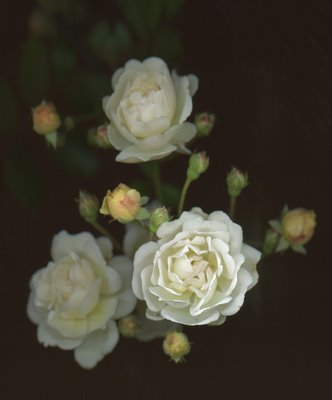
Most of my roses are on the wane. Some have fat buds but you know they are not going to open. But I was surprised yesterday afternoon to see that Rosa 'Sweet Juliet' had one nice open flower and its scent was carrying far in spite of the cool afternoon. I was more surprised to find that Rosa 'Ghislaine de Féligonde'(left) had a nice cluster with buds and open flowers. I only purchased her this year. Her name is French but my Australian, The Ultimate Rose Book by Sterling Macoboy states:
Pronounce the lady's name as 'Elaine de Féligonde' and you have got over the main obstacle to the revival of this rose, its awkward Flemish name. It is rarely seen these days, but it is one of the most charming Ramblers, with the added bonus that it sometimes bears a second crop of flowers. The fat little buds are quite strong a yellow, but they open to the palest cream with pink tints. Foliage is glossy green and resistant to mildew. It was raised by the French firm of Eugene Turbat et Cie and introduced in 1916. 'Ghislaine de Féligonde'is of fairly restrained vigor.
'Golfinch' x unknown
Repeat Flowering
Right next to Ghislaine I spotted the curious effect of Hypericum androsaemum 'Albury Purple' whose fruits were showing the transition from yellow to blue black. Hypericums have the lowly popular name of St. John's wort because of its traditional flowering on St John's day, 24 June. The genus name Hypericum is derived from the Greek words hyper (above) and eikon (picture), in reference to the traditional use of the plant to ward off evil, by hanging plants over a picture in the house during St John's day.

There are several species of Hypericum, all having yellow flowers. Most are considered ordinary but I have found that my particular cultivar is a fine garden plant. It sometimes gets rust so I have to tear out the plant. But Albury Purple seeds itself so I am always able to replace it.
Not far from Ghislaine and Albury Purple I found this moth. It was fluttering its wings just a bit, about to die in the cold of the coming evening.
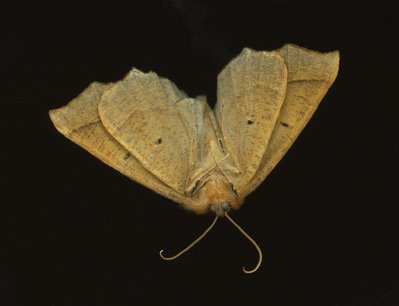
The moth might have searched for protection under my Japanease anemones, Anemone x hibrida 'Margarete'(pink) and 'Whirlwind', white) (below). I call them the soldiers of the garden because you plant them in the back of a bed and they soon march forward. But how can I complain when they are still in bloom in mid October?
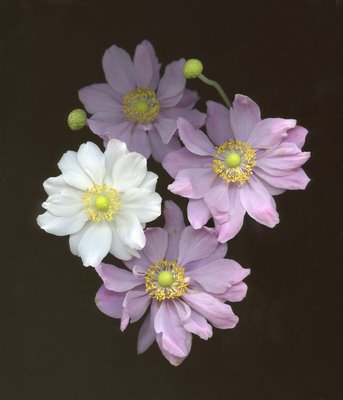
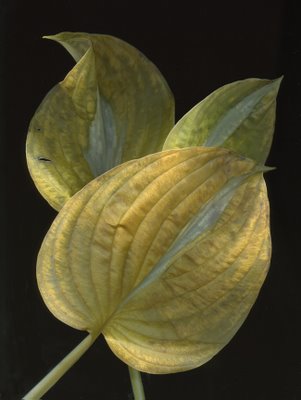
It is difficult not to look at my fall garden and not think of myself and Rosemary. I notice how time has affected us, more gradually perhaps, but the decay is there. It is much too late to buy a red Miata to feel young or pretend (at least for me) that those women in all the gossip magazines or in those Hollywood films we rarely see are attractive to me. They are much too young.
After all these years can it really be possible that happiness is shopping for socks, shirts and jeans at Mark's Work Wearhouse? It seems so.
If someone had told me only ten years ago (the idea of becoming a grandfather was so anathema, that as soon as Rebecca was old enough to talk, I instructed her to call me Papi and not grandpa) that happiness was going to be shopping with Rebecca for cheese at Bossa on Victoria Drive and for Maldon Salt and Yorkshire Gold Leaf Tea at the Gourmet Wearhouse on East Hastings I would have been speechless. I did just that yesterday. I had no idea then of the pleasure of buying Rebecca green apple ice cream at Mario's Gelato on 1st Avenue and Quebec Street and sitting on a stool to savour the ice cream and a beautifully waning sunny Saturday. I could not have known of the pleasure of walking with Rebecca and Lauren to our nearby park at Osler Elementary School and playing in the swings and then running across the field to see who would get to the red fire hydrant first. I did, but then, Rebecca probably let me win or slowed down as Lauren cried as she could not keep up to us.
For years I have specialized in making an excellent cheese fondue. I use Swiss Gruyere, Emmental and Appenzeller. I use a pinch of nutmeg, lots of freshly ground pepper (Tellicherry), white wine and real Kirsch. But it has only been until know that I have had to compete with anybody (my daughters never even tried) to get that last brown part that collects in the bottom of the fondue pot. Rebecca and I both fought for it last night. It felt good to fight for it.
And just as I did with Rebecca years ago, Lauren and I walked to 41st and Athlone yesterday afternoon to watch when Hilary (Lauren's mother) stepped down from the bus with her precious cargo of fresh bread for our fondue.
Above you see a scan of leaves of Hosta 'Risky Business'. In summer she is dark green with a white centre. She is a mutation of Hosta 'Strip Tease'. Just like I appreciate the beauty of these leaves on their way to decay and disappearance in the early winter earth I have come to understand that I have to be like those leaves to finally understand that happiness is all the above.
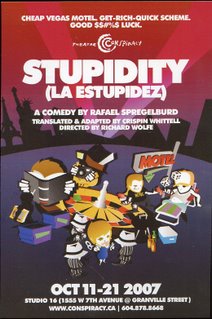
The idea of going to a play called Stupidity with my snooty wife Rosemary (she tends to not like anything) was a daring one on my part. The play was originally la estupidez and was written by Argentine playwright Rafael
Spregelburd. Theatre Conspiracy's production was the world premiere of the play in English. Before going into the theatre I asked Theatre Conspiracy director (who directed this play) Richard Wolfe why an Argentine writer would write a play set in Las Vegas. He told me that Argentina was broke in 2000 and playwrights were daring and desperate.
Having not seen the part on the toothbrush I wondered if my porteña godmother and first cousin, Inesita O'Reilly Kuker (86) might have attended las estupidez. When the toothbrush scene happened Rosemary whispered, "I don't think Inecita saw this play."
But I am happy to report that Rosemary laughed as much as I did, as five actors played more parts than I could possibly count, putting on and removing (back stage) outfits faster than I ever thought non-strippers ever could. There were parts in this extremely funny play where I felt I was watching a fast tennis match as my head switched from one side of the set to another as two simultaneous scenes unfolded.
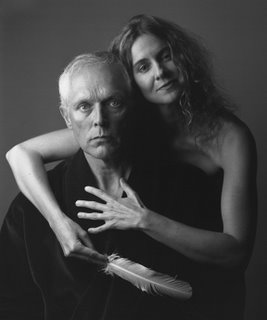
In the cast of five ( Jahann Helf, Nicole Leroux, Allan Morgan, Naomi wright and Alex Zahara), Allan Morgan (seen here with Sarah Rodgers in a photo I took last year, Angels in America, Part 1 and Part 2) and Nicole Leroux, who played the funniest wheel-chair-bound "creature", stood out for me. The sign language communication by the blue-band cop Morgan and Leroux had Rosemary and I almost slapping our knees like Americans.
I have therefore two recommendations:
1. Go and see this play at Studio 16, 1555 West 7th Avenue, which runs until October 21st.
2. Never brush your teeth without making sure you hold the brush with a rubber glove.
3. Allan Morgan should consider branching out into stand-up comedy. His Japanese businessman, Lee Okazu was as funny as things can get.
Theatre Conspiracy
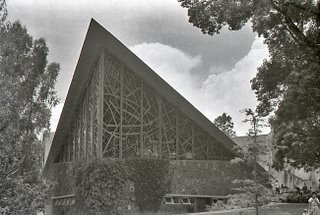 Felix Candela
Felix Candela
(b. Madrid, Spain 1910; d. 1997)
Felix Candela was born in Madrid in 1910. He entered Madrid's Escuela Superior de Arquitectura in 1927 and graduated in 1935. Sidetracked by his political struggle against Franco, he did not practice architecture until he emigrated to Mexico in 1939.
Candela believed that strength should come from form not mass. This belief led to an extensive exploration of tensile shell structures. His nickname became "The Shell Builder" because of this structural favoritism.
Frequently forced to act as architect, structural engineer and contractor in order to further his work, Candela sees architects as engineers who possess the ability to design both great cathedrals and low cost housing.
References
Dennis Sharp. The Illustrated Encyclopedia of Architects and Architecture. New York: Quatro Publishing, 1991. ISBN 0-8230-2539-X. NA40.I45. p35.
Gottfried Wilhelm Leibniz and Sir Isaac Newton co-discovered the calculus in the 17th century and unleashed on the world the destructive power of ballistics. Before the limits, derivatives, integrals, and infinite series of the calculus, ballistics was all guess work. With Newton's discovery of gravity this meant that military engineers could predict with a fair amount of accuracy where a canon shell would fall. And of course the calculus in combination with the German V-2 rocket presaged the cold war and the accurate delivery of a mutually assured atomic destruction.
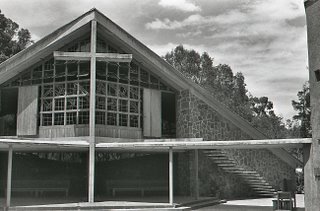
But the calculus enabled mathematicians to discover the formulas for calculating the volume of cylinders, cones, spheres and of irregular three dimensional shapes. Along the way curves like parabolas and hyperbolas could be studied under the concept of infinitesimals. Somebody, perhaps in the late 19th century, may have found a practical application of studying these curves in three dimensions and noting the shape that was subsequently made in that space. That person may have held four or five pencils in one hand (with the points touching on one end while fanning out the pencils, not only in relation to their length and width but also in depth) and been amazed at the shape. This shape is called a hyperbolic paraboloid or hypar. That shape can be constructed by using perfectly straight metal or wooden beams.
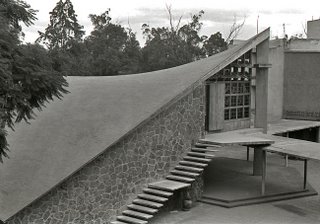
In Mexico architect/structural engineer/contractor Felix Candela popularized the thin concrete shell. To this day even some of the old Pemex gas stations built in the 50s and 60s (and perhaps inspired by Candela) still stand with their wonderful swooping concrete shells.
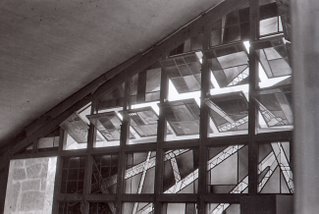
Around 1962 I first found out about the Capilla (chapel) de Nuestra Señora de la Soledad in the Mexico City suburb of Churubusco. This chapel, affectionately called El Altillo (small hill) was built by architect Enrique de la Mora y Palomar in collaboration with Fernadez López Carmona and Félix Candela (the structural engineer). The beautiful stained glass windows were designed by Kitzia Hoffman. My initial interest had nothing to do with this chapel that was built in the middle of a 17th century monastery. Those that knew went to Sunday Mass at 10am to hear the monks sing in a spectacular Gregorian chant. But when I noted the architecture and saw the deceptively complex (or simple depending from which side you saw it) I knew I wanted to return with my Pentacon-F 35mm camera and its one 50mm lens.
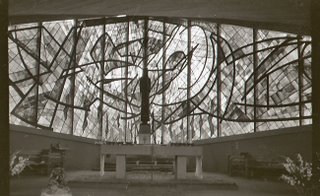
It was around 1964 that I learned integral and differential calculus and was able to see how the volume of a cone was calculated (there are two wonderful ways). It was a small "Road to Damascus" sort of thing for me as was the discovery of the concept of a straight line with an infinitely varying slope in three dimensional space. I then came to understand Candela's obsession with hypars.
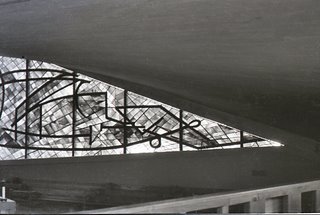
Now there is this new building designed by Arthur Erickson that is being built on Georgia Street. The building has a twist and.........
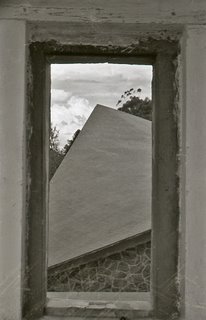
For beautiful colour photographs of "El Altillo" by Mexican architect José Luís Parella look here
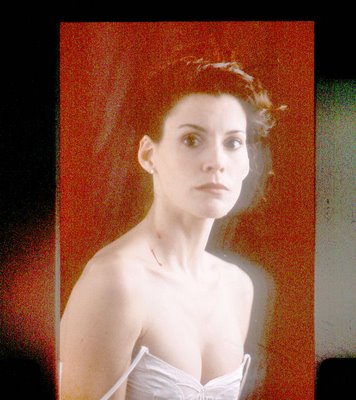
A few days back in Intimacy On The Net - Not there was quite a reaction to the image of the young lady posing with my Smith Corona PWP-40. Quite a few sent me queries on who she was. I first photographed Katheryn Petersen around 1990 and the first pictures were for Vancouver Magazine. After that she was frequent subject of mine in my studio and in outdoor shoots in Lighthouse Park. The best pictures I ever took of her came from her own ideas.
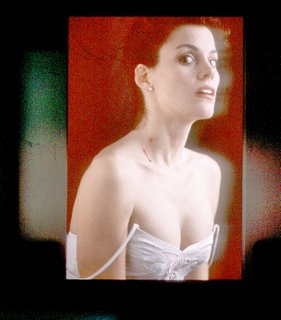
She would come into the studio and pretty well ask me, "Are you ready?" I always had that distinct impression I was not to ask questions and just shoot. And this I did. This is the other side of the coin of the idea that you cannot take pictures of someone unless you have some idea of what you are going to do. I tell my students that the worse thing a photographer can do is hire a model and then tell her/him to do something. This will guarantee failure in the session. But Katheryn is one of those rare persons who has a rich imagination and is not afraid to draw from it.
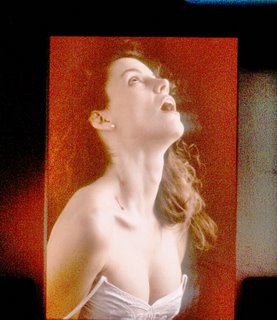
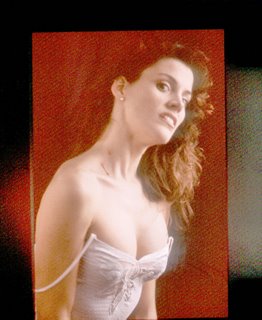
She arrived and we took some pictures with flowers that were happy - not in the least memorable. Then she put on the white camisole, opened a jar of theatrical blood and put some on her neck. I began to take pictures and she was oblivious to my camera, her eyes got glassy eyed as she drifted away into the role of the vampire, first sad, then ecstatic and finally she looked she turned into my camera and scared me almost to death.
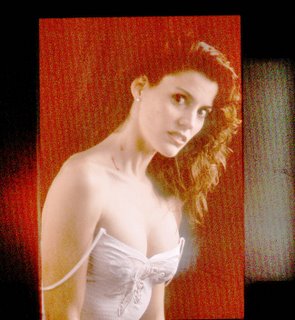

Few who ever visit the Vancouver Art Gallery look outside it. On the Howe side there is a flower bed of New Guinea Impatiens that is about as ugly as a flower bed can be. There are traffic circles with grasses, care of the Vancouver Parks Board, that are beautiful and in comparison even more so. On the Hornby side of the gallery, whatever grass used to grow there has been trampled to non existence by movie personnel and their heavy lights. On Georgia Street the gallery is defaced by a hideous Olympic clock. The clock and the nearby rock fountain, in combination would be enough to kill architect Arthur Erickson on the spot if you happen to mention them. He has long suffered because of that fountain. Don't even mention the seasonal coloured lights!
In the mid 90s, J. Brooks Joyner (left), the director of the Vancouver Art Gallery was my friend. We often had tea in my garden or at the Vancouver Hotel. I complained to him about the New Guinea Impatiens and he would laugh. He told me he was doing his best to try to install outdoor sculpture to dress up the exterior of the gallery. He told me that keeping the grass in good shape was difficult as the gallery received good annual revenue from movie and TV crews who liked to use the interior when they needed a realistic court room. Once over tea at the Vancouver Hotel he confirmed what my friend, art collector Samuel Frid had told me about a Frida Kahlo show that had flown to Japan, via Vancouver by Japan Airlines. It had been Willard Holmes, one of Joyner's predecessors who had nixed a kind offer from the Mexican government to stop the show in Vancouver on its way to Japan. It seems that there was no way to get the insurance money in time. In 1996 somehow Joyner (top left) was unable to fit into the city art establishment. There was a little palace coup and he was let go.
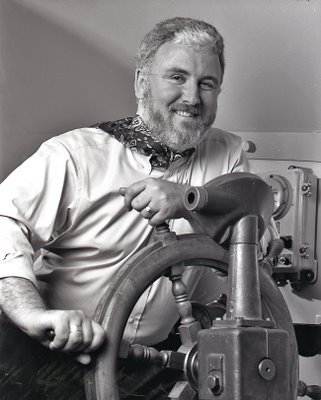
It is only recently that I lost another friend to intelligent head hunters. James Delgado, the former head of the Vancouver Maritime Museum was under appreciated here. This man had lots of energy, lots of ideas and connections and like Joyner he is an American. There is nothing like an American to know how to market and how to sell.
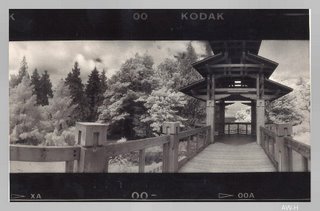
In the 90s Joyner and Delgado would meet for lunch or dinner and discuss ideas minus all the red tape that gallery and museum bureaucracies often have. The made plans and plotted joint shows. One of them would have been a show of maritime art that would have made the public want to go from the gallery to the museum, back and forth. There was a new director at the Museum of Anthropology so they were planning on inviting her to the meetings. With Joyner gone in 1996 Delgado was left alone and he almost languished while trying to coax us into looking out towards the sea.
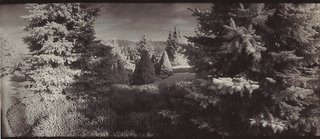
Only once did I really see a concerted and extremely successful effort in combining the resources of more that one city cultural institution. Sometime in the 80s Presentation House in North Vancouver had a show of the Swiss photographer Robert Frank who forced Americans to look at themselves in his famous 1958 book The Americans. From photography Frank had switched to making avant garde films. These films were shown at the Pacific Cinematheque on Howe Street.
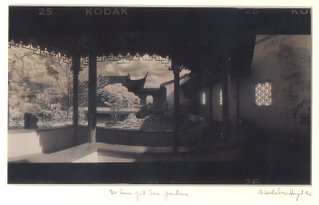
The icing to the cake was the showing of Frank's Cocksucker Blues on a video loop at Presentation House Gallery. This famous documentary that followed the traveling Rolling Stones influenced MTV and music videos.
A prime example of a total lack of interaction is to look at our municipal(you have to pay to get in) gardens. These are UBC Botanical Garden And Centre For Plant Research(top, middle), its associate garden the Japanese Nitobe Memorial Garden (below in colour), VanDusen Botanical Garden (top,left) and the Dr. Sun Yat-Sen Classical Chinese Garden (right).

Because you have to pay it means that they need the public's entry fees. Only one is really part of the city in the sense that the Vancouver Parks Board runs VanDusen. None of these gardens ever join forces and try to create a path of garden visitors that would want to make them visit all four gardens.
VanDusen and the Vancouver Art Gallery are a prime example of what happens during a city wide strike. The former has been closed for 82 days and it has lost all the summer tourist revenue plus the revenue of all those film companies that rent the gardens to shoot. Somehow the arrangement at the Vancouver Art Gallery makes it impervious to the current strike.
Perhaps now is when the city should consider getting these four gardens under one administrative roof and use them to attract more tourism. Joyner and Delgado would be figuring out how to bring in those gardens into their fold, too.
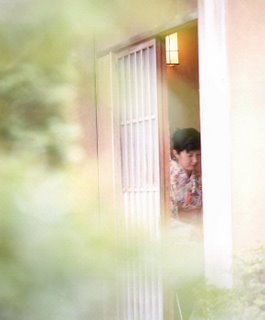
It is a scandal that a beautiful city like Vancouver cannot have a viable yearly plant and garden show to compete with Seattle and others around the world. Since the VanDusen version (successful on sunny years) is so dependant on public funding it is time the city step in so that this yearly show could make our city a botanical tourist Mecca.
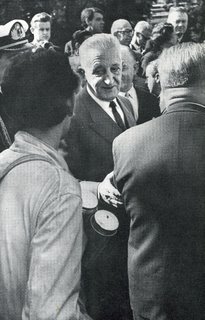
Not only do I not understand parliamentary democracy, crossing the floor, and no confidence votes I don't understand some of the other salient features of living in a democracy. An example is the strike. Why must so many people surround buildings and then march around with signs hanging from their neck? Prior arrangements could be made between the unions and the management to the effect that, "We won't be outside if you don't try to get in." Then those on strike could go on strike-pay holidays.
It was in the early 60s that I first read Albert Camus's El Extranjero ( I read it in Spanish) while living in Mexico City. I was deeply affected in reading how Meursault complained of the heat during his mother's wake and then how he went to see a comic movie after her funeral. This sort of thing made sense in a city (Mexico City) where bus drivers were paid per round-trip routes taken in one shift. The faster the drivers went, the fewer people to stop to pick up, the more routes they would finish and the more money they would make. It made perfect sense to me. And these bus drivers were told that if they ran over anybody they were to go in reverse and run them over again to make sure they were dead. Law suits were a pain in the neck. It was easier to pay off the widow or the widower, the mother or the father.
From living with the absurd I learned to live with the military logic of Buenos Aires under a general called Juan Carlos Onganía. On the day after the military coup, June 28, 1966, that sent our country doctor president Arturo Ilía (above in Time/Life photo) home in a cab, the first decrees passed by the junta (Onganía plus the heads of the Argentine air force and the navy) dissolved congress, eliminated all parties and the constitution was deemed a worthless piece of paper. Months before the coup, a local nespaper, El Mundo had published editorial cartoons in a Sunday magazine called Tía Vicenta in which Ilía was drawn as a turtle (slow democracy) and the general as a walrus because of his mustache. The general banned Tía Vicenta.

After these decrees the milicos decided that Argentine youth was being corrupted in dark night clubs. They decreed a minimum watts-per-square-meter in ceiling lights so that Argentine youths could count their money before paying their bill. This seemed entirely logical. It was also logical that my sailor's pay (equivalent to one US Dollar a month, since the pay rate had not changed since the 1920s) would be a crisp new bill in an IBM perforated envelope. Argentina was most modern!
Buenos Aires has an excellent, subway system, urban and interurban rail and many buses. You don't really need a car to go anywhere, except when you have transit strikes or general strikes. In general strikes the city stops except for the post office inside workers who must first throw all the mail that is inside, out the window, including the pay cheques of the retired. I saw this many times and when the strike was in the summer (as they often are) it was like a rare summer snowfall. With no transit, Buenos Aires becomes a knot of cars. But generals are logical and they often decide that public transit is an "essential" service. It was then that I first became aware of this word with so many meanings. So when the buses and trains went on strike, the petty officers of the navy ran the trains and we sailors checked for tickets, kept the train cars clean, etc. The air force petty officers drove buses and the army dealt with the subways. It was perfectly logical. Even Meursault would have nodded his head in agreement. And those sailors and soldiers of low rank had to pick up the garbage during general strikes. That was logical, too, since I was never singled out to do it.
I thought that upon coming to Vancouver that kind of logic would no longer come into play. That was not to be. I find that being on this side of the equator hasn't changed things much. Consider that our present city council and mayor (or whoever is in charge) stated (decreed?), when our city strike began some 81 days ago, that parking enforcement was an essential service but garbage collection wasn't.
I would not want the generals to come back, but if some retired old military guy with some semblance of logic would suggest we switch the definition of essential from parking enforcement to garbage collection, about now, that would suit me fine.
And as for Doctor Arturo Ilía I met him in 1972 when he was on a lecture tour through Latin America. He came to the Jesuit university, Universidad Iberoamericana in Mexico City where I was teaching spanish to foreign students. I was introduced to him. I told him I had seen him leave the Casa Rosada in a cab. With a little, but forgiving smile on his face, he looked at me and said, "It could have been worse, I could have been shot. And you were only obeying orders."

Here’s the thing: the Net’s killer app has always been other people. There are side benefits, like access to all the world’s information. But the links that matter aren't between pages but people, and they’re strong and rich and subtle. Multiply the infinite flavors in human relationships by a thickening bundle of means-to-connect; that product is what’s new and what’s good and what’s exciting. People who are looking for the Next Big Thing are mostly looking in the wrong places. And anyway, you don’t need to look, it’ll find you.
From a fragment in Tim Bray's ongoing
The above statement and what followed hit me hard. The idea that a self-defined computer programmer (Tim Bray of Sun Microsystems) would be at all interested and aware of intimacy in human relationships, instantly removes him from my obviously misguided idea that computer programmers are people who are extremely shy, avoid all human contact and hide behind impenetrable technical methods and terms.
In my life I have achieved a relative amount of intimacy through writing. At first (and almost all of my life) it was frustrating. I had learned the qwerty keyboard but my dyslexia made typing a chore. Writing long hand became a problem after age 30 when, for reasons I cannot understand, my handwriting rapidly deteriorated and became illegible not only to me but to those I wrote to.
I was liberated around 1990 by a Smith Corona PWP (personal word processor, see above photograph) which enabled me to correct on a small screen without having to violently tear out the sheet of foolscap, rumpling it into a ball and throwing it into the waste basket. I avoided computers and computer attached word processors even when I hooked up to the internet in January 1995. At the time I was writing quite a few freelance stories for the Vancouver Sun and I wrote them all in Eudora and sent my finished copy as a Eudora document.
Since 1995 I have seen a familiar pattern of sudden intimacy that generally breaks down quite quickly. Friends or relatives of mine get hooked up to the net and I suddenly get requests for detailed accounts of my life until the very minute I press-and-send. These emails are followed by jokes with hundreds of disclosed recipients and if my friend or relative is from Argentina I get inundated by the best (read worst) SPAM in the world, Argentine Spam. I think I understand.
These people who are new in the net suddenly feel that those that they communicate with are part of an "intimate" and personal community. They don't stop to think that it is a virtual community and we cannot visit them for tea. My relationship with these friends and relatives soon sours when I reply to them and all their disclosed recipients with an email that has an attached nude of questionable taste. I cannot abide by this forced sense of intimacy that I am supposed to feel by being reachable by email.
When I first started this blog I had the idea (for exactly one day) that I wanted feedback. I quickly came to realize that I was not interested in the opinions of people I did not know and I could do without comments here. I have seen to many photography forums, plant forums and otherwise excellent on line magazines like BC's The Tyee fall prey to nasty ranters who live (many do) in bleak parts of BC's interior.
While I direct the personal intimacy of my blog towards myself, my immediate family and a few friends, I have become aware that writing on a monitor screen can often be dangerous in ways that haunt us (sooner) or later. In the first election that Stephen Harper was running for prime minister I was genuinely afraid he would win. As someone who has always voted NDP I was in a moral quandary. I decided to post my decision the evening of elections in the The Tyee's, Election Night Forum. I wrote that I had photographed and taken the posters for the electoral campaigns of both Jack Layton and Ujjal Dosanjh. I liked and admired both. But with my fears that Harper could win I had decided not to vote with my heart (the NDP) but with my brain (the Federal Liberals). This was then posted by CBC National on to their TV screens that evening and I have never heard from the NDP for photography work since.
I still do not understand the intimacy of being part of Flickr or facebook. They seem to be larger versions of my friends's communities.
But there is one attribute of the web and email that I still enjoy. I am able to have good written communication (be it intimate or not) with my friends (I never send them jokes or any other type of junk) and especially with my first cousins in Buenos Aires. One of them is also my godmother and she is 85. Until we began to write via email she was a remote relative. That, she is no longer.
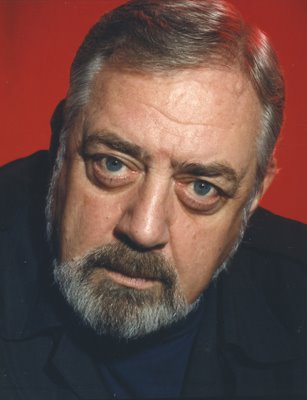
I photographed Raymond Burr twice. The first time it was 1986 (seen here in colour) and the second time a few years later. In the first sitting I worked with writer Les Wiseman and Vancouver Magazine and in the second with John Lekich for the Georgia Straight. I remember the second session better because of my two camera failures.
New Westminster born (1917) Burr was a very large man. In order to take the best portrait I used a longish Mamiya lens (140mm, the lens in the bottom of the picture). With this lens I could focus on his face (while being not too close) so that all of Burr's features were in a proper proportion.

That second session Burr was much larger and spoke about restaurants with Lekich. I took a Polaroid with the 140mm which pleased Burr and me. When I put on the b+w film back and took my first exposure, nothing happened. The main spring of the lens's shutter had failed. I was then forced in using that not as long 90mm lens (the upper lens in the picture) which if used at the distance I had used the 140mm woul have made Burr's nose look extra large. I had no choice except to use that 90 but pulled back to get more of the body (something I did not want to do) with the idea of then cropping in for the magazine. And that's how it was.
When I processed that roll I noticed that one exposure was a double one. This rarely happened or happens with my Mamiya RB Pro-S or the newer model I now have the Pro-SD. These cameras have an excellent double exposure prevention mechanism. It is only for today's blog that I ventured to see what that double exposure looks like.
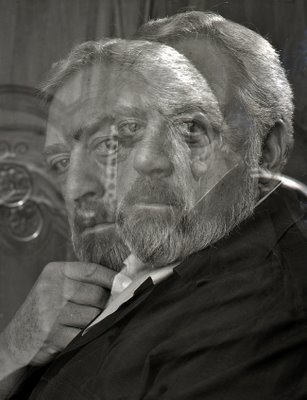
Burr was one of the warmest and most charming men I ever met. His role as the would-be wife murderer in Alfred Hitchcock's Rear Window scared the hell out of me the first time I ever saw it. It always troubled me to reconcile the actor acting that with the person I photographed twice. Yet I think that this double exposure somehow shows that duality of the charmer and the man capable of cutting up his dead wife with a saw and stuffing the parts in a suitcase.
Shortly after I took that second picture I decided I would never take my chances again and I purchased a second 140mm. I never leave home without both of them in my camera bag.

For those who don't want to read yet another gushy account on my perfect granddaughter Rebecca, stop reading now. And if that weren't enough I am bonding with Rebecca's sister Lauren and more gushy accounts on her will soon follow these pages.
Hilary's (my daughter and Rebecca and Lauren's mother) godmother, my Argentine born cousin Rosario (Chayo) says foam just pours out of my mouth when I write about my granddaughters. She does the same when she proudly tells me of her much accomplished twin sons, Paul and Roncito. Foam was pouring out my mouth last night.
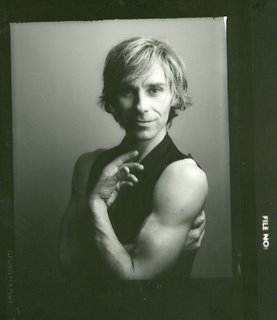
Last night Rebecca and I went to the East Vancouver Cultural Centre (affectionately known as the Cultch by its enthusiastic patrons). We were there to see Noam Gagnon's The Vision Impure. We were amply informed, several times (they felt like warnings to me), that the show had loud music, smoke, strobe, foul language and nudity. Rebecca and I survived it.
Rebecca is a veteran of Chick Snipper's 2003 Slab (also at the Cultch) in which three dancers wore, as Rebecca likes to say, "Nothing." And 2003 was back then so no matter how many times Gagnon threatened or hinted that he was going to take it all off he never did! Nudity applied to seeing the incredibly strong and talented Sonja Perreten's chest.
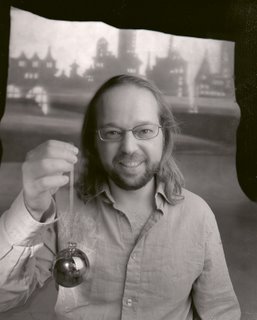
One of the dancers in Slab (besides Kathleen McDonagh and Anne Cooper) was Susan Elliott (in charge of rehearsals for The Vision Impure). Her mother, Jo-Anne was sitting next to Rebecca. She recognized Rebecca from a picture that she has of her with Susan so they chatted and compared notes most of the evening. We were also sitting behind videographer artist and photographer jamie griffiths (she insists her name be in lowercase) who besides lighting designer, Itai Erdal (left), composer Stefan Smulovitz (below, right) and others (including the wondrously voiced Viviane Houle) were involved in making this show a show we will long remember.
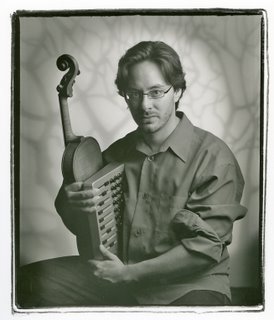
We liked all of it but we particularly liked a segment of narration of a person's body parts (none that you might think) in relation to the soul and existence, danced solo by Gagnon with skill, humour and whimsey.
We finished the evening with sushi (Rebecca) miso (me) at Kishu Island on Main and Broadway. Rebecca said, "This is becoming a ritual." Yes.
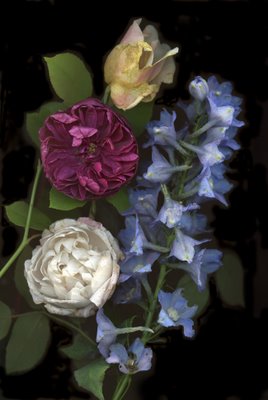
Our city strike is the excuse Rosemary and I are using for not venturing into the garden. At about this time on any other year we would be busy cutting back some of the plants and I would be pruning to size the rambler roses like Rosa 'Albertine'and Rosa dupontii. The latter is about 14ft high. Our large green bin is full and with the city not picking it up for at least a couple more weeks I would have no place to deposit all the stuff I would cut. In years past we have taken advantage of some of the neighbours' green bins which never fill up except with grass clippings. We use grass clippings for mulch in late summer to keep the dry areas of the garden moist, we put them into our compost and in most of spring and summer I leave the clippings on the lawn.
Yesterday it rained while the sun was out. My Hungarian friend Paul Leisz says one of the few Hungarian sayings of his youth that he remembers is the one that applies to that rainy sun. Hungarians say that when that happens it is because the devil is whipping his wife and that explains the confusion.
Ale is coming this weekend from Lillooet and we are to have our Thanksgiving dinner on Saturday night. I will have to go into the garden today and see which ornamental grasses I can divide so Ale can take them back. We are experimenting to see which of our plants will survive Lillooet's Zone 3 weather. Any hostas would as would roses that have rugosa parentage. Rugosas originated in Northern Japan, Korea and Siberia.
Before I mowed the lawn (I try to do this before it rains) I brought in a few flowers which I scanned. The light blue delphinium grew nicely in our back lane but Rosemary is disappointed that this New Zealand variety is not the deep blue she really covets. The dark red rose is English Rose Rosa 'L.D. Braithwaite', the about to open bud is Reverend Pemberton's Rosa 'Bishop of Darlington' and the near white rose is the Bourbon rose Rosa 'Mme Pierre Oget'.
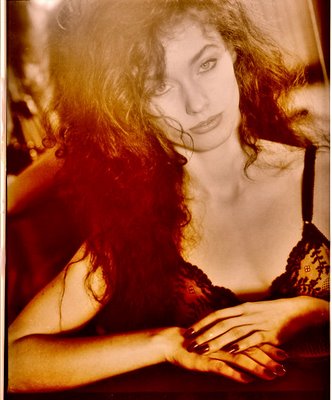
Some years ago I photographed a high tech executive. I then took the photograph to my friend Ian Bateson who manipulated it so that instead of having the executive look at the camera he was looking down. I placed by straight 8x10 next to a computer monitor and I loaded Ian's digital image on to the computer. The resulting photograph showed the executive on the screen looking down on himself on the desk. What was particularly striking (for me) in those early days of Photoshop was Bateson's ability at manipulating the photograph with the skill of an illustrator and artist who had, in his youth, done his share of life drawing. Bateson knew (and knows) how skin behaved. He knew (and knows) how skin droops. He was able to manipulate Photoshop realistically because of his knowledge of anatomy.
In the early 80s I was blindly pursuing the photographic "art" called glamour photography. Glamour is an in-between (between the clothed and unclothed) type of photography that is now seen, because Maxim rules the magazine stands, as tame and cheesy. The king of glamour (note that Americans do not use that u in colour and behaviour but keep that u in glamour) was Peter Gowland.
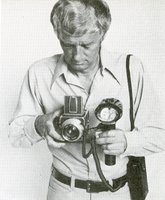
He pioneered in the 50s and 60s the use of the electronic flash with young women wearing bikinis while frolicking in California beaches. And like Bunny Yeager, who made Betti Page famous he photographed his women uncloathed in poses that did not show any of the bits and pieces.
In the 80s the process was to get the young lady to come into your studio. You had that perfectly stupid idea that some wine and loud heavy metal music would eventually lead the young lady to suggest that she would take it all off. And, yes, this happened a few times. And I felt extremely guilty about it. It is far easier now to book a model who will come to your studio and undrape immediately. And in many cases not only do you not pay them but you have young women calling you and willing to pay you if you will photograph them undraped.
Lost in all this is the fact that if one studies the undraped human body and experiments in the movement of limbs one is able to understand how the body behaves. One understands how to manipulate grace if grace is not there. And once these bodies are photographed with clothes - grace, poise and confidence can be exploited. My portraits today are all the better for all those glamour photographs and nudes I shot in my past.
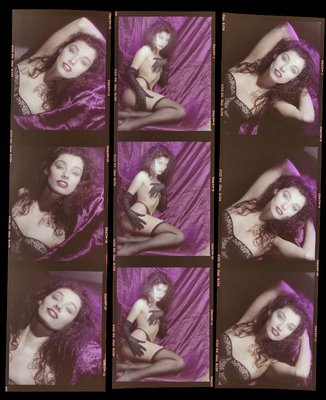
In my attempts at glamour I remember fondly Annette (top left and right), who patiently posed for me for lighting experiments I had no idea on how to do. And she even managed to look her best in spite of those lighting experiments.
Here you see a photograph of Peter Gowland with that horrible pioneering flash unit the Honeywell Auto Strobonar. I had a couple of them (they still work!). They had a habit of failing when you needed them not to.

And also here is a photo by Gowland of the exotically named Ava DeLa Sabliere.
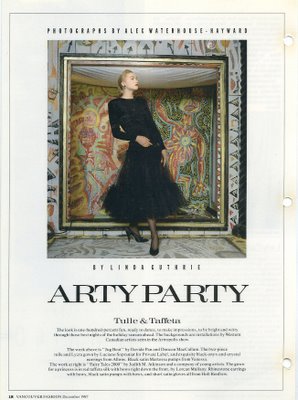
It was here where I wrote of my short-lived career in fashion photography. Back then (1987) I kept telling those who asked me why I didn't shoot fashion that it had all to do with the fact that I was perceived as being uncool. I didn't have the proper "attitude". I could not take photographs of people and show "attitude". I never did learn what that word meant. It was a word that described those who passed muster as fashion photographers and those who didn't. Those of us who asked what the word meant were much like those who asked what jazz was. And if you have to ask.....But by 1987 Vancouver Magazine's fashion editor, Linda Guthrie, for reasons I never understood, had alienated every fashion photographer in Vancouver. She came to me and said, "Alex I know you can shoot fashion. I want you to shoot a spread for me." At the time I had the lofty title of Director of Photography at Vancouver Magazine. Mac Parry had created this position being ahead of his time (a talent he has in spades) in foreseeing the eventual power of photo editors in magazines. So I was reluctant to take this job on and suggested I look for another photographer. Guthrie insisted so I was on. We shot for a whole day at that year's Artropolis. Just to make my shoot that much more difficult I decided I needed to use a boom to hold my optical spotlight.
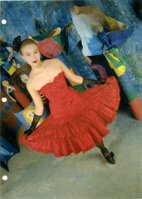
The Manfrotto Super Boom was a big thing to carry. I was determined to use some of
George Hurrell's lighting techniques. I could not work on my own with all the stuff so I hired the legendary Torontonian photographer Bruce Simpson to assist me.
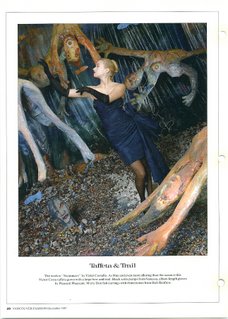
Our model was 6 ft tall. She explained to me that she was ballet dancer who had been fired by the National Ballet of Canada because she had grown to be too tall for the leading men. Our makeup artist (in the parlance of cool fashionistas, a word I despise, she would be a MUA)told our model that since her mouth makeup was so complicated she was not to drink, eat or smoke.
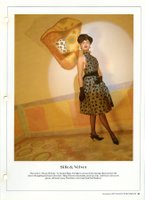
I looked at the model and told her, "If you don't drink, eat or smoke, I won't drink, eat or smoke." She looked at me without saying anything. We worked for a whole long day and she never complained. I might have known. We were in it together and she was all mine.
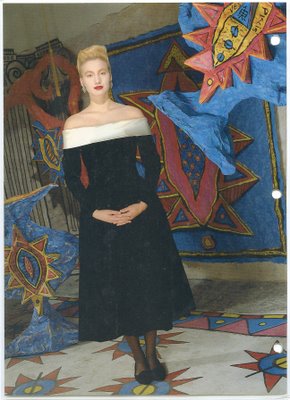
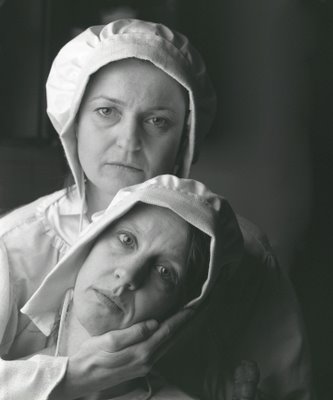
My grandmother Lolita often told me, "Nadie te quita lo bailado." Roughly into English it means, "Nobody can take away the enjoyment of the dances that you have danced." I believe she was ahead of her time. She never told me to not do this or that. Her tack was, "If you do this, this is what is going to follow." Most of her sayings came from Cervantes's Don Quijote de la Mancha. I thought I had forgotten many of them and now I find that in the presence of Rebecca, who might be doing something she should not be doing, I suddenly remember the ones that fit. It is sort of like the botanical Greek and Latin nomenclature of the plants in my garden. It all but disappears as winter sets in and as soon as spring comes I can utter Betula utilus var. jacquemontii (Himalayan Birch) without a problem.
And as the winter gloom sets in I can always smile if I think of two of the funniest actresses in town, Manon Beaudoin (top, left) and Lois Anderson (bottom, right) from Leaky Heaven Circus. But when they want to be serious, they can make you cry. Manon Beaudoin is now writing plays and Lois Anderson is the most accomplished actress in Vancouver. She almost stole the show from Jonathon Young in Trout Stanley. But it was then that I discovered that Anderson could not only laugh and make me cry but she was also ravishingly sexy.
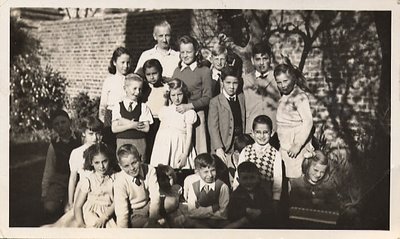
Names conjure people. A lovely young woman at Lyon rose grower, Odile Masquelier's lecture this Saturday to the Vancouver Rose Society came up to me and asked, "Are you Alex? I am Monica. I read your blog." She smiled, turned around and left. She was completely out of context in a room full of much older people. When she had come in and sat in the beginning of the lecture I had wondered about her.
I have been affected by three Monicas in my past. The first one I went to school with in Buenos Aires. She was always invited to my birthday parties and managed to break the piñata, put the tail on the donkey, win the bag race and break all my new toys. To this day I am not sure if I hate birthday parties and birthday cakes because of this Monica. In the picture here she is below my father, top left.
But I got even with her even if I didn't mean to. I still get dizzy in buses or in cars when I am not driving. As a child it was much worse and I could not enjoy swings or ride any form of transportation except the train. Going to visit my abuelita with my mother in old tram 35 was torture. One weekend Monica and her parents picked me up in their brand new 1949 Chevrolet. I remember it had a pristine cloth interior. I got very sick in it. I have no idea how they cleaned my mess. We arrived at some house and they served what looked like fantastic pizzas. I was famished and I asked for some. All I remember was that they said, "No." To this day that was the finest pizza I never ate.
The second Monica was Saint Monica the mother of Aurelius Augustine, Bishop of Hippo. My mother said I was her St. Augustine and she was my St. Monica. I misbehaved a lot and she suffered, she would tell me all the time. "But there is hope for you, Alex," she said, " because Augustine became a saint and Monica, too for having to bear that burden that he was most of her life." Only in recent years after reading Jostein Gaarder's That Same Flower - Floria Amelia's Letter to Saint Augustine did I find out about Monica's dark side. She was jealous of Augustine's mistress Floria and did all she could (and was successful) to separate them.
Floria writes:
On your way back to Africa you arrived at Ostia on the Tiber. There you and Monica had a "wonderful conversation" in which you sought "to discover the nature of the eternal life in which the saints shall participate." The conversation led you to "conclude that the greatest pleasure the bodily senses can give, in the most radiant earthly glory, is, to the joy of eternity, not even worthy of comparison, let alone mention.
You must forgive me, Your Grace, but I am a cultivated woman now. So in all humility I feel a certain need to suggest that this sounds like some kind of conjuration. For what if you should be wrong on precisely this decisive point?
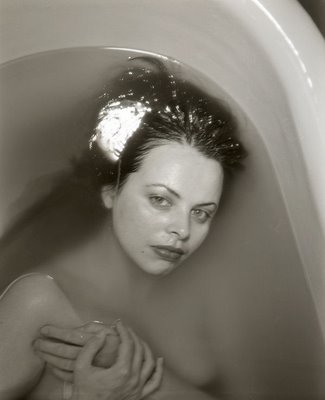
The third Monica, Monica Salvatella (also an Argentine), posed for me in my tub some years ago. She was a photographer, very cosmopolitan and sophisticated. She told me that she was going to live on a farm on Vancouver Island and I never saw her again.
As for the fourth mysterious Monica I know nothing except that in some way her smile touched my heart and she answered in spades for me when people ask me, "Why do you blog?"

The gloom of the fall rain and the promise of the winter cold are wonderfully compensated by the warmth of going to listen to my friends play music. My friends (incuding violinist/violist Paul Luchkow, below) are the musicians of the Pacific Baroque Orchestra.

They play baroque music standing up (read below) very close to where I sit in the protective and intimate environment of a church. They perform music that is rarely played on the radio. It is fresh, exciting, challenging and satisfying. I often attend with my friends Graham Walker, Abraham Rogatnick and my granddaughter Rebecca.
-----------------------------------------------------------------------------------------------------
Delirio Amoroso: Handel's Italian Years
Alex Weimann - Guest Director
Washington McClain - Oboe Soloist
Saturday, October 27, 2007, 8.00 p.m.
St. Augustine's Church, Vancouver
2028 West 7th Avenue (corner of Maple and West 7th)
Sunday, October 28, 2007, 2.30 p.m.
West Vancouver United Church
2062 Esquimalt Avenue (at 21st Street and Marine Drive)
----------------------------------------------------------------------------------------------------------------------------------
In September 2002 the Pacific Baroque Orchestra, my favourite Canadian orchestra, and its leader, violinist Marc Destrubé introduced their first CD with the Haydn violin concertos in G, C and A major. The CD cover photo of Destrubé was my last contribution as a two-year trustee of the orchestra.

My journey into an intimate musical enlightenment began while munching on a bag of fish and chips (with my daughters Ale and Hilary) on May 13, 1980 at the Orpheum Theater in Vancouver. John Eliot Gardiner (seen here in CBC's Studio 1 where I photographed him in 1979) was directing the CBC Vancouver Orchestra in a series called A Little Lunch Music. The program featured Bach’s concerto in D minor for 2 violins.

That year Gardiner had begun to verse the ensemble in baroque performance practice, and had introduced period bows and tuning. At the concert Gardiner showed us the difference in sound between the modern and baroque violins. I was hooked to the latter’s quieter but warmer sound.
On Sunday October 27, 1996 at Ryerson Church in Vancouver. A local baroque group founded in 1990, the Pacific Baroque Orchestra, played the Vivaldi Gloria in D major RV 589. The concert not only opened my ears but also my eyes. The musicians, with the exception of the cellists, the bassist and the harpsichordist, to my consternation, were all playing standing up. The big surprise was the all female Electra Women’s Chorus. I had never heard a Vivaldi Gloria with an all female chorus. The performance introduced me to red-haired sisters Caitlin (a mezzo soprano) and Phoebe MacRae (a soprano) who were featured soloists. In later years I would enjoy hearing Caitlin with Vancouver’s Musica Intima and Phoebe as a frequent soloist with the PBO and with the Modern Baroque Opera (now sadly gone).
Soon I found myself going to all the performances of the PBO. I was particularly attracted to sitting in the front rows and hearing the group playing in intimate concert venues, usually churches. It was a surprise to me when two years ago I was called by PBO manager Tom Durrie called me to ask me to be a trustee. My wife suggested that this could be a good career move for me. A more cynical member of the Vancouver Symphony, pianist Linda Lee Thomas told me, “It’s for free pictures, and you’re a photographer.”
My wife was wrong, I spent too much time worrying about the finances of the PBO and little on our own. While I did provide the PBO with free pictures the two-year experience was rewarding and an eye opener in many ways.
I had erroneously thought that as a trustee I would get to see all the concerts for free. No, I had to pay. I thought that being a trustee would be a prestigious endeavor I could boast about. In a city where the arts are suffering what some call a “fund raising burnout” I found I had to help organize golf tournaments. I hate golf. Who would ever know that one of the problems was to find someone who would transport the harpsichord to a concert?
For a while my media connections served me well. When countertenor Matthew White was to appear at a concert with the PBO I called up CBC Radio’s Paul Grant and offered to take to his studio a grown man who sang in a falsetto. The subsequent interview helped fill seats. But soon calling my friend Vancouver Sun music critic Lloyd Dykk put me into the dilemma: was I wearing the hat of friend or of PBO trustee wanting exposure for the band?
As a trustee I found out the nightmarish financial problems that most arts organizations are in. Budgets include federal, provincial and city grants that are not always sure things. Not getting a grant can spell an operating disaster which fund-raising events can only partially alleviate.
After two years as a trustee I feel that the closer contact I had with musicians (many showed up at the board meetings) has given me a further insight into music, baroque music and how it is played.

From Destrubé I found out that until Ludwig Spohr invented the violin’s chin rest emotion in music was heard through the composer’s music. “Once the chin rest was there,” Destrubé said, “ the music could be heard in the musician’s head. We could now feel the music and express ourselves through it.” He further explained that the French Revolution marked the decline of rich patrons for music and composers and musicians had to rely on ordinary citizens to foot the bills. This meant larger concert halls where instruments had to be louder. Baroque instruments were beefed up to allow for strings under higher tension. The warmth of the baroque instruments was superseded by the need for a louder sound.
While being a trustee did not, in the end make me feel important, I have learned that sitting up front at a PBO concert is no different from being a king of a European country of the 18th century. These musicians are there, close, playing just for me.
And why do members of the PBO play standing up? Marc Destrubé explained, “Just like rock and roll musicians connect with their audience by standing, I feel we can, too."
PBO
More PBO
And even more PBO
Nelson McLachlan, Sabu & A Manfrotto Super Clamp
Sunday, October 21, 2007

Yesterday Rebecca, Lauren, Rosemary and I watched Alexander Korda's wonderful 1942 film The Jungle Book with Sabu. I particularly thought it appropriate for Rebecca as I wanted her to see the Kipling classic in a film with real people and real animals. I didn't want it to be an animated film. Rebecca liked it (even though Sabu kills Shere Khan and does not run away as in the PC Disney film) and wasn't too sure if the crocodile was real all the time. "Perhaps it was a trained crocodile," she said. Later in the evening she was watching a terrible film with Terrence Stamp (the villain) and Eddie Murphy (the hero). It had lots of special effects and swordplay and levitations. The contrast between the films made me think of the concept of special effects. In The Jungle Book the special effects consisted in trying to make a Hollywood lot look like an Indian jungle. The war made it impossible to shoot it on location. In the 90s I was well known for photographic special effects in the magazine business, before Photoshop brought us penguins in the Sahara.
There was one special effects photograph I had taken but I could not remember the name of my subject until I found the old Vancouver Magazine tear sheet from May 1990 yesterday. It had been one of those Sean Rossiter 12th & Cambie columns, this one called The Pedal Pushers. It was a column that was well ahead of its time as it told the story of Nelson McLachlan who, to quote Rossiter:
Nelson McLachlan was sitting in his snazzy new metallic brown 1982 Toyota Cellica fastback, idling in the lat-afternoon traffic jam at 41st and Granville, when he had one of those almost religious experiences that occur to all of us but get forgotten by the time we find a parking spot. Barely 22 years old, still paying inflation-era interest on his car loan although the economy was in a freezer, McLachlan suddenly saw that he was working full time for no other reason than to make the payments of his car.
This is crazy, he thought. He pulled into Granville Toyota (at 41st), quickly agreed to accept $7,500 cash for the Celica - it needed vacuuming - and took the Number 3 Road Richmond Express, home to the 18-speed, custom frame bike that had cost him $1000.
Rossiter wrote on how McLachlan became chair of the city's Bicycle Advisory Committee and spearheaded making it mandatory for downtown office developers to build bike racks and changing facilities. The article was airing the problem of the fact that cyclists could not ride the SeaBus and buses had no bike racks. In short McLachlan probably helped a lot in making Vancouver an almost bike friendly city. I wonder where he is now and is he still cycling down from Richmond to Vancouver?
For the photograph I wanted to do something sharply different from the usual panned shot of a sharp cyclist with a blurred background. I attached a Nikon FM-2 with a fisheye lens and a motor drive to the front hub of McLachlan's bike tire by using a then (and now) legendary Manfrotto Super Clamp.

This clamp can bind firmly anything to anything. I had to trust the clamp not to fail as expensive equipment would have literally bitten the dust. I wrapped a remote motor drive button (in the picture here you can see glimpses, on the left side of the picture on the handle bar) and told McLachlan to drive back and forth (but take pictures only on the side that had sun on his face. We shoot three rolls of 36 exposures. Art director Rick Staehling chose this one for the spread and we had a massive argument.
It has always been my belief that whoever presses the shutter of a camera is the person who takes the picture. I told Staehling that the photograph had to be photocredited to McLachlan. We finally compromised on a joint credit.
Wen Wei Wang, Karissa Barry, Vivaldi & Alison Denham's Abs
Friday, October 19, 2007

There is one book in my library that I have never finished. It is Russel Hoban's 1980 Riddley Walker. It is an apocalyptic novel much like my favourite A Canticle for Leibowitz but I cannot struggle past chapter one. Hoban invented a language for the main protagonist Riddley who speaks in a devolved form of English, with a much changed spelling and resembles a phonetic transliteration of a Kentish accent. I have given up on this book. Riddley Walker is defined as an ergodic novel. An ergodic novel requires a "non-trivial effort" to traverse the text. This effort must be extranoematic, that is, it must consist of more than simply reading by moving one's eyes along lines of text, turning pages and mentally interpreting what one reads. My favourite José Saramago, who is very stingy with punctuation, is a mild example of ergodic literature.
Sitting on the front row with Rebecca last night at the Cultch watching the hour long dance program, Three Sixty Five by choreographer Wen Wei Wang was sort of like ergodic dance if there is such a thing! The music was composed by Giorgio Magnanensi and the score was pre-recorded with the addition of the never boring and very live cello of Peggy Lee. The music seemed to me like a devolved Four Seasons by Antonio Vivaldi. And there was a reason for this. Wen Wei Wang says this in his choreographer's statement:
After four years of work with my own company I wanted to challenge myself as a creator and push myself beyond my own cultural roots. Vivaldi's Four Seasons was my inspiration for this work and is also the basis for Giorgio Magnanensi's composition. This has been a great challenge for me. Vivaldi's music is so beautiful, so well known and so often chosen by choreographers that it required a fresh and imaginative treatment in order to succeed. This project was not just to create new movement but a way for me to understand another culture through its music.
My last work, Unbound, was the result of my proceeding choreographies and I regard Three Sixty Five as the beginning of an important new phase in my choreographic career. As I enter this phase I want to go beyond everything I have previously expressed through movement.
-Wen Wei Wang
I relied on my own imagination to figure out this one hour long dance that pushed the five dancers with constant and grueling movement to the limit of their abilities. Five dancers (sparingly dressed in white) and one musician (Peggy Lee), a troupe of entertainers in a space ship from Proxima Centauri on their way to Sirius get lost and crash land on our planet. We have been gone for a while. In a dump site Lee finds a boom box with a tape (Vivaldi's Four Seasons). Radioactivity and age have affected both the tape and the box. What plays (every once in a while you can recognize Vivaldi, the rest of the time it seems to sound like program music)is the score we heard last night.

Lee puts in her interpretation and the dancers do likewise. I felt both trapped and mesmerized by the performance. A white violin hangs from the ceiling. The dancers and the musician have discovered a cult to the instrument. They are in awe of it.

And so were we in awe of the five dancers, Wen Wei Wang (slippery and fit like a Weddell Sea seal), Scott Augustine (a prime example of this new breed of Vancouver contemporary dancers who are compact and with their low centre of gravity can move with incredible speed) Karissa Barry (when I saw her in the mentor program at Arts Umbrella she already stood out. She is another one of those compact and strong dancers) Andrea Keevil (willowy in contrast to the rest) and lastly Alison Denham. Of Denham, Rebecca said, with amazement, "What abs!" Unlike Hoban's Riddley Walker I think I could handle Three Sixty Five one more time.
There is one more performance of Wen Wei Wang's Three Sixty Five tonight at the Vancouver East Cultural Centre.

Rosemary and I attended the opening on Wednesday evening of the Daniel MacIvor play His Greatness based on a potentially true story about two days in 1980 (in a Vancouver hotel room) in the last years of the life of Tennessee Williams. He died in a New York hotel in 1983. The play (on until November 10 at the Granville Island Stage of the Arts Club Theatre Company) is superbly played by Allan Gray, David Marr and Charles Christien Gallant. Alas I never had the opportunity to photograph any of them so others are posted here as surrogates.
Rosemary, my wife, rarely likes anything but on Wednesday night she was smiling with pleasure and glee.
Yes, I laughed a lot, particularly when playwright MacIvor made fun of our two-newspaper town. But I was dead serious and uncomfortable (paradoxically) because of the uncanny reconstruction by Scenery Director Kevin McAllister and Lighting Designer Alan Brodie of what to me has to be a Hotel Vancouver suite. I should know as I have photographed many actors, politicians, directors, authors, pornography stars, etc in many Vancouver hotels and quite a few of them at the Hotel Vancouver.
One of my first Hotel Vancouver subjects and, certainly one that gave me lots of pleasure was a sitting with poet/novelist Timothy Findley in October 1988. While I was certainly no Young Man, played with a wicked panache by Charles Christien Gallant, I was the younger and third person in that Hotel Vancouver suite. The second was Findley's friend Bill Whitehead. At the time I discussed with the friendly Findley ("Please call me Tiffy.") the idea of some day having a show of hotel portaits. In January 1989 I received a kind letter from Findley that raised the question of those hotel portaits.

I wonder if anybody snapped His Greatness when he was in Vancouver? I must state that I first became interested in taking photographs in Vancouver hotel rooms when I saw the picture (seen here) of Mark Twain holding court from his bed in the (yes!) Hotel Vancouver when he visited our city on August 18, 1895.

I include here a photograph of American writer Richard Ford whom I photographed at the Hotel Vancouver in October, 1990. He had come to town for the Writer's Festival. I had taken the liberty of calling the Hotel Vancouver publicist to tell her that of all the persons who were staying at the hotel the one who would most likely write about the hotel was British travel writer (by then he had moved to Seattle) Jonathan Raban. I did not know that Raban and Ford were friends. While I was taking Ford's picture (I'm happy," he said to me, "you are making me look like Graham Greene."), Jonathan Raban walked in and said, "Richard I have this great big room that is semicircular and occupies a whole end of the hotel. I have no idea why I have been given this room." Ford countered with, "Mine is a normal room. Somebody must like you." I said nothing.

Rosemary and I drove home from His Greatness. We were silent but content. After all it had been an excellent evening at the theatre. While I had missed Tennessee Williams's stay in Vancouver, the play had carried me back to that hotel room in my head, haunted by all those ghosts, some dead some alive that have passed in front of my camera and through my life.
Alejo Carpentier, A Drunken Antonio Vivaldi, Motezuma & A Mexican
Thursday, October 18, 2007

In 1995 when I read Mexican poet and novelist Homero Aridjis's novel ¿En quien piensas cuando haces el amor?, I was perplexed by the mention of a Vivaldi opera called Motezuma. I figured this was simply a sample of Homero Aridjis's brand of Magic Realism. This was not the case. When I interviewed him at his Mexico City home in 1997 he said it was a long lost opera.

He also told me that what was most interesting is that in the premiere in 1773, Vivaldi's mistress Anna Giró had played the lead female part. Aridjis said he had first read about the opera in an Alejo Carpentier novel. When I returned to Vancouver I went on an Alejo Carpentier binge taking out most of his books from the excellent collection at the UBC Library. It was there that I discovered Carpentier's novella Concierto Barroco.
I don't know why but in the middle of the night, last night, and the reason for this blog today, I dreamt of a character (above) I had photographed near the Zócalo (Mexico City's main square) in 1997. I never saw his face as he walked quickly away in his colourful indian clothing. He and a musician I photographed a few blocks away, made me remember my favourite Arijdis poem that conjures the ghosts of people from the past mingling with us. Was that man Moctezuma's ghost? Or could it have been the Grand-Tour-Mexican dressed as Moctezuma (read below) come back to Mexico aftr his binge in Venice?
"Invisible ancestors
walk with us
through the back streets
car-noises
the stares of children
young girls's bodies
cross through them
Weightless and vague
we travel through them
at doorways that no longer are
on bridges that are empty
with the sun on our faces
we too
move toward transparency." Homero Aridjis - Letter From Mexico

Moctezuma was first portrayed on the stage in 1695 in Henry Purcell’s masque The Indian Queen. Purcell got it wrong as Montezuma is seen as a young Inca general in the Peruvian army. Jean Philippe Ramaeu’s lncan setting in Les Indes Galantes is now thought to be the first serious work on the new world set to music. The fact is that two years before, in the autumn of 1733, Antonio Vivaldi premiered his first opera, Motezuma in the Teatro Di Sant’Angelo with a libretto by Alvisi Giusti. Anna Giró, Vivaldi’s supposed mistress, sang the lead female part. A meeting between Vivaldi, Handel and Domenico Scarlatti (who had been seent by his father Alessandro to seek his musical fortune in Venice) during the Christmas carnival in Venice in 1709, by all accounts had no bearing with Vivaldi’s opera Motezuma.
But Cuban born writer Alejo Carpentier (1904-1980), who coined the term lo real maravilloso or “magic realism”, thought otherwise.
In his 1974 short novel Concierto Barroco (the same title in the English translation available at the Vancouver Public Library and at the UBC Library in Spanish) a bored rich Mexican goes on a grand tour of Europe with Filomeno, black Cuban servant who has a fondness for women and trumpets. Bored in Madrid, the Mexican ends up in the Venice carnival in 1709. Dressed as Moctezuma, (his black servant, decides that his face will do as a mask) runs into the composers, all three very drunk, in a dark corner of Victorio Arduino’s Botteghe di Caffe. The idea for the opera is born when Vivaldi questions the Mexican on his costume. That Vivaldi doesn’t get the story quite right (or the name as any Mexican who knows history will tell you it's Moctezuma not Montezuma or Motezuma) could be blamed on his inebriated state.

What follows is one of the most delightful stories I have ever read. An impromptu concert with the composers and Vivaldi’s foundlings ( with the wonderful names, Pierina del violino, Cattarina del cornetto, Guiseppina del chitarrone, etc…..) at the Ospedale della Pieta, leads into a session with Louis Armstrong charming Handel and the Cuban servant with his rendition of I Can’t Give You Anything But Love.
It should come as no surprise to those who may have read other books by Carpentier, an eminent music critic and musicologist, that in Concierto Barroco he uses this knowledge to play jokes and twist time, while educating us. The Mexican and the composers have a picnic on Igor Stravinsky’s tomb, who some credit with having said, “Vivaldi wrote the same concerto 600 times.” Thus we find out that Stravinsky is buried In Venice (but did not die there) while another character in the novel, Richard Wagner in a casket, died but is not buried in Venice.

If Concierto Barroco is a literary potato chip that has you wanting more I would recommend Jose Saramago’s Baltasar and Blimunda wherein Domenico Scarlatti plays the harpsichord in early 18th century Portugal while the novel’s heroes Baltasar and Blimunda build a flying machine.
Wondrous Dance At The Museum Of Anthropology
Wednesday, October 17, 2007

I receive email announcements from Vancouver arts publicists. This profession in Vancouver is as endangered as the Stanley Park penguins. So I would never, ever call it spam. These publicists need all the help we can give them. As an example why would anybody leave home on a lazy late October or November afternoon? This is the announcement that I received from the Museum of Anthropology, admission is $9.00, $7.00 for seniors and students.
Stimulating the Senses: A Sunday Series of Music and Movement
Kokoro Dance: “Heart, Mind, Spirit, & Soul”
Sunday, October 28, 2007, 3:00 pm
Kokoro Dance merges kinetic and visual elements from Japan and the West to create a uniquely Canadian Butoh aesthetic. This concert is presented as the second in our Sunday series of three dance and music performances, “Stimulating the Senses: Music and Movement at MOA.”
“Move It!” – Joe Ink
Sunday, November 18, 2007, 3:00 pm
“Move It! is everybody’s chance to groove. Find your feet in the participatory workshop with Tara Cheyenne Friedenberg and Jacci Collins.
--------------------------------------------------------------------------------------------------------------------------------
I don't think I have ever seen Jacci Collins but I can tell you plenty about Kokoro and Tara Cheyenne (who now includes her married name. Damn!) Friedenberg.
Of Kokoro (that's Jay Hirabayashi and Barbara Bourget below, left) I already wrote here but I have never told you about Tara Cheyenne.
I first photographed her in my studio for the Georgia Straight and she told me she was going to appear in one of the Dances for a Small Stage. She told me she was going to be a mermaid. She didn't come with the costume to my studio but we made do. Since the Straight is a family publication she offered to tape her nipples. They showed in my Polaroids. We used gaffer tape!

Dancing at Dances for a Small Stage is a challenge as the stage is small. But I was not prepared to see what I saw. Cheyenne sort of splashed on stage and stayed in one spot. Can mermaids dance? She made seal noises and moved her upper body in amazing sinuous movements. Since then I have been amazed by her virtuosity.
Now there is a recently retired choreographer of note, Chick Snipper (of Slab fame, seen here with Cheyenne, right) who also noted her virtuosity. Upon retiring, Snipper handed over her company to Cheyenne.
A few days back at Stupidity I ran into Cheyenne. I can report (and if you cannot justifiably describe the body of a dancer then what's left?) that she looks even more voluptuous than I remember her and I see many reasons why we should leave the comfort of our home on a lazy (and probably bleak) Sunday, November 18 afternoon.

And what of the other Sunday, October 28 afternoon with Kokoro Dance? If you have never ever seen Butoh here is your chance to see this Japanese 20th century dance form inside a perfect venue, Arthur Erickson's Museum of Anthropology.
The Feline Question II
Tuesday, October 16, 2007

This photograph has appeared before here but it is constantly before me as I go up and down the stairs to and from our bedroom. It hangs outside the bedroom hall. It is impossible to miss. It is special in many ways, the least of which, is the easiest to explain.
I cannot do justice to the print here. I scanned the framed photograph and the glass added some green I had to remove. The print is one of six pictures of Rebecca that I made from a found envelope of Agfa Portriga that was hiding in a dark corner of my darkoom. The paper was long discontinued by Agfa and Agfa is now gone. The paper was very special as it had a rich warmish tone that produced what is called split toning when I immersed the fixed and washed print in a very strong solution of selenium. Because the paper was expired it developed a few extra colours of its own which can never be duplicated.
And of course I can never duplicate the moment or the experience of snapping this picture of Rebecca in the Buenos Aires Botanical Garden. The garden is known for its varied and rich sculpture, its cats (hundreds of stray cats and left cats) and for a fading glory of plants that with no budget have to manage on their own.
It was perhaps here (in that garden) where the Vancouver-born Rebecca developed that air of sophistication that I hope will never leave her. I further hope she will inherit my mother's flair. She always used to tell me, "Alex, hay poca gente fina como nosotros." There are few people as sophisticated (Spanish fina or fino is a combination of gentle manners, too) as we are."
Last week our neighbourhood had an art show at the nearby Osler Elementary gym.
It was an evening affair with wonderful food and sweets. I brought 11 pictures of Rebecca. But because we were told to think of the venue (children) I knew I would have had a problem if I had taken this, the finest of all the pictures of Rebecca along. I didn't.

It was when Rebecca was 6, a few months before we went to Buenos Aires four years ago that I took Rebecca to the Calabria Bar on Commercial. We sat right under a reproduction of Michelangelo's David. Rebecca asked the obvious question and I explained why it was sculptors favoured the nude. It has been one of our favourite places for cappuccino in the city. Rebecca calls the table under David, "Our table." Shortly after, one afternoon of sipping mate and chatting Spanish with Juan Manuel Sanchez and Nora Patrich, Rebecca and I returned home. She decided to do her interpretation of Sanchez's nudes with their perfectly round breasts.
French Ramblers, Hypericum, A Moth & Soldiers In The Garden
Monday, October 15, 2007

Most of my roses are on the wane. Some have fat buds but you know they are not going to open. But I was surprised yesterday afternoon to see that Rosa 'Sweet Juliet' had one nice open flower and its scent was carrying far in spite of the cool afternoon. I was more surprised to find that Rosa 'Ghislaine de Féligonde'(left) had a nice cluster with buds and open flowers. I only purchased her this year. Her name is French but my Australian, The Ultimate Rose Book by Sterling Macoboy states:
Pronounce the lady's name as 'Elaine de Féligonde' and you have got over the main obstacle to the revival of this rose, its awkward Flemish name. It is rarely seen these days, but it is one of the most charming Ramblers, with the added bonus that it sometimes bears a second crop of flowers. The fat little buds are quite strong a yellow, but they open to the palest cream with pink tints. Foliage is glossy green and resistant to mildew. It was raised by the French firm of Eugene Turbat et Cie and introduced in 1916. 'Ghislaine de Féligonde'is of fairly restrained vigor.
'Golfinch' x unknown
Repeat Flowering
Right next to Ghislaine I spotted the curious effect of Hypericum androsaemum 'Albury Purple' whose fruits were showing the transition from yellow to blue black. Hypericums have the lowly popular name of St. John's wort because of its traditional flowering on St John's day, 24 June. The genus name Hypericum is derived from the Greek words hyper (above) and eikon (picture), in reference to the traditional use of the plant to ward off evil, by hanging plants over a picture in the house during St John's day.

There are several species of Hypericum, all having yellow flowers. Most are considered ordinary but I have found that my particular cultivar is a fine garden plant. It sometimes gets rust so I have to tear out the plant. But Albury Purple seeds itself so I am always able to replace it.
Not far from Ghislaine and Albury Purple I found this moth. It was fluttering its wings just a bit, about to die in the cold of the coming evening.

The moth might have searched for protection under my Japanease anemones, Anemone x hibrida 'Margarete'(pink) and 'Whirlwind', white) (below). I call them the soldiers of the garden because you plant them in the back of a bed and they soon march forward. But how can I complain when they are still in bloom in mid October?

Risky Business, Tellicherry Peppercorns & Grandchildren
Sunday, October 14, 2007

It is difficult not to look at my fall garden and not think of myself and Rosemary. I notice how time has affected us, more gradually perhaps, but the decay is there. It is much too late to buy a red Miata to feel young or pretend (at least for me) that those women in all the gossip magazines or in those Hollywood films we rarely see are attractive to me. They are much too young.
After all these years can it really be possible that happiness is shopping for socks, shirts and jeans at Mark's Work Wearhouse? It seems so.
If someone had told me only ten years ago (the idea of becoming a grandfather was so anathema, that as soon as Rebecca was old enough to talk, I instructed her to call me Papi and not grandpa) that happiness was going to be shopping with Rebecca for cheese at Bossa on Victoria Drive and for Maldon Salt and Yorkshire Gold Leaf Tea at the Gourmet Wearhouse on East Hastings I would have been speechless. I did just that yesterday. I had no idea then of the pleasure of buying Rebecca green apple ice cream at Mario's Gelato on 1st Avenue and Quebec Street and sitting on a stool to savour the ice cream and a beautifully waning sunny Saturday. I could not have known of the pleasure of walking with Rebecca and Lauren to our nearby park at Osler Elementary School and playing in the swings and then running across the field to see who would get to the red fire hydrant first. I did, but then, Rebecca probably let me win or slowed down as Lauren cried as she could not keep up to us.
For years I have specialized in making an excellent cheese fondue. I use Swiss Gruyere, Emmental and Appenzeller. I use a pinch of nutmeg, lots of freshly ground pepper (Tellicherry), white wine and real Kirsch. But it has only been until know that I have had to compete with anybody (my daughters never even tried) to get that last brown part that collects in the bottom of the fondue pot. Rebecca and I both fought for it last night. It felt good to fight for it.
And just as I did with Rebecca years ago, Lauren and I walked to 41st and Athlone yesterday afternoon to watch when Hilary (Lauren's mother) stepped down from the bus with her precious cargo of fresh bread for our fondue.
Above you see a scan of leaves of Hosta 'Risky Business'. In summer she is dark green with a white centre. She is a mutation of Hosta 'Strip Tease'. Just like I appreciate the beauty of these leaves on their way to decay and disappearance in the early winter earth I have come to understand that I have to be like those leaves to finally understand that happiness is all the above.
Stupidity, Theatre Conspiracy & The Toothbrush
Saturday, October 13, 2007

The idea of going to a play called Stupidity with my snooty wife Rosemary (she tends to not like anything) was a daring one on my part. The play was originally la estupidez and was written by Argentine playwright Rafael
Spregelburd. Theatre Conspiracy's production was the world premiere of the play in English. Before going into the theatre I asked Theatre Conspiracy director (who directed this play) Richard Wolfe why an Argentine writer would write a play set in Las Vegas. He told me that Argentina was broke in 2000 and playwrights were daring and desperate.
Having not seen the part on the toothbrush I wondered if my porteña godmother and first cousin, Inesita O'Reilly Kuker (86) might have attended las estupidez. When the toothbrush scene happened Rosemary whispered, "I don't think Inecita saw this play."
But I am happy to report that Rosemary laughed as much as I did, as five actors played more parts than I could possibly count, putting on and removing (back stage) outfits faster than I ever thought non-strippers ever could. There were parts in this extremely funny play where I felt I was watching a fast tennis match as my head switched from one side of the set to another as two simultaneous scenes unfolded.

In the cast of five ( Jahann Helf, Nicole Leroux, Allan Morgan, Naomi wright and Alex Zahara), Allan Morgan (seen here with Sarah Rodgers in a photo I took last year, Angels in America, Part 1 and Part 2) and Nicole Leroux, who played the funniest wheel-chair-bound "creature", stood out for me. The sign language communication by the blue-band cop Morgan and Leroux had Rosemary and I almost slapping our knees like Americans.
I have therefore two recommendations:
1. Go and see this play at Studio 16, 1555 West 7th Avenue, which runs until October 21st.
2. Never brush your teeth without making sure you hold the brush with a rubber glove.
3. Allan Morgan should consider branching out into stand-up comedy. His Japanese businessman, Lee Okazu was as funny as things can get.
Theatre Conspiracy
Hypars, Leibniz, Newton, Félix Candela & Arthur Erickson
Friday, October 12, 2007
 Felix Candela
Felix Candela(b. Madrid, Spain 1910; d. 1997)
Felix Candela was born in Madrid in 1910. He entered Madrid's Escuela Superior de Arquitectura in 1927 and graduated in 1935. Sidetracked by his political struggle against Franco, he did not practice architecture until he emigrated to Mexico in 1939.
Candela believed that strength should come from form not mass. This belief led to an extensive exploration of tensile shell structures. His nickname became "The Shell Builder" because of this structural favoritism.
Frequently forced to act as architect, structural engineer and contractor in order to further his work, Candela sees architects as engineers who possess the ability to design both great cathedrals and low cost housing.
References
Dennis Sharp. The Illustrated Encyclopedia of Architects and Architecture. New York: Quatro Publishing, 1991. ISBN 0-8230-2539-X. NA40.I45. p35.
Gottfried Wilhelm Leibniz and Sir Isaac Newton co-discovered the calculus in the 17th century and unleashed on the world the destructive power of ballistics. Before the limits, derivatives, integrals, and infinite series of the calculus, ballistics was all guess work. With Newton's discovery of gravity this meant that military engineers could predict with a fair amount of accuracy where a canon shell would fall. And of course the calculus in combination with the German V-2 rocket presaged the cold war and the accurate delivery of a mutually assured atomic destruction.

But the calculus enabled mathematicians to discover the formulas for calculating the volume of cylinders, cones, spheres and of irregular three dimensional shapes. Along the way curves like parabolas and hyperbolas could be studied under the concept of infinitesimals. Somebody, perhaps in the late 19th century, may have found a practical application of studying these curves in three dimensions and noting the shape that was subsequently made in that space. That person may have held four or five pencils in one hand (with the points touching on one end while fanning out the pencils, not only in relation to their length and width but also in depth) and been amazed at the shape. This shape is called a hyperbolic paraboloid or hypar. That shape can be constructed by using perfectly straight metal or wooden beams.

In Mexico architect/structural engineer/contractor Felix Candela popularized the thin concrete shell. To this day even some of the old Pemex gas stations built in the 50s and 60s (and perhaps inspired by Candela) still stand with their wonderful swooping concrete shells.

Around 1962 I first found out about the Capilla (chapel) de Nuestra Señora de la Soledad in the Mexico City suburb of Churubusco. This chapel, affectionately called El Altillo (small hill) was built by architect Enrique de la Mora y Palomar in collaboration with Fernadez López Carmona and Félix Candela (the structural engineer). The beautiful stained glass windows were designed by Kitzia Hoffman. My initial interest had nothing to do with this chapel that was built in the middle of a 17th century monastery. Those that knew went to Sunday Mass at 10am to hear the monks sing in a spectacular Gregorian chant. But when I noted the architecture and saw the deceptively complex (or simple depending from which side you saw it) I knew I wanted to return with my Pentacon-F 35mm camera and its one 50mm lens.

It was around 1964 that I learned integral and differential calculus and was able to see how the volume of a cone was calculated (there are two wonderful ways). It was a small "Road to Damascus" sort of thing for me as was the discovery of the concept of a straight line with an infinitely varying slope in three dimensional space. I then came to understand Candela's obsession with hypars.

Now there is this new building designed by Arthur Erickson that is being built on Georgia Street. The building has a twist and.........

For beautiful colour photographs of "El Altillo" by Mexican architect José Luís Parella look here
A Vampire Visits My Robson Street Studio
Thursday, October 11, 2007

A few days back in Intimacy On The Net - Not there was quite a reaction to the image of the young lady posing with my Smith Corona PWP-40. Quite a few sent me queries on who she was. I first photographed Katheryn Petersen around 1990 and the first pictures were for Vancouver Magazine. After that she was frequent subject of mine in my studio and in outdoor shoots in Lighthouse Park. The best pictures I ever took of her came from her own ideas.

She would come into the studio and pretty well ask me, "Are you ready?" I always had that distinct impression I was not to ask questions and just shoot. And this I did. This is the other side of the coin of the idea that you cannot take pictures of someone unless you have some idea of what you are going to do. I tell my students that the worse thing a photographer can do is hire a model and then tell her/him to do something. This will guarantee failure in the session. But Katheryn is one of those rare persons who has a rich imagination and is not afraid to draw from it.


She arrived and we took some pictures with flowers that were happy - not in the least memorable. Then she put on the white camisole, opened a jar of theatrical blood and put some on her neck. I began to take pictures and she was oblivious to my camera, her eyes got glassy eyed as she drifted away into the role of the vampire, first sad, then ecstatic and finally she looked she turned into my camera and scared me almost to death.

Parking Enforcement & Other Absurdities Part II
Wednesday, October 10, 2007

Few who ever visit the Vancouver Art Gallery look outside it. On the Howe side there is a flower bed of New Guinea Impatiens that is about as ugly as a flower bed can be. There are traffic circles with grasses, care of the Vancouver Parks Board, that are beautiful and in comparison even more so. On the Hornby side of the gallery, whatever grass used to grow there has been trampled to non existence by movie personnel and their heavy lights. On Georgia Street the gallery is defaced by a hideous Olympic clock. The clock and the nearby rock fountain, in combination would be enough to kill architect Arthur Erickson on the spot if you happen to mention them. He has long suffered because of that fountain. Don't even mention the seasonal coloured lights!
In the mid 90s, J. Brooks Joyner (left), the director of the Vancouver Art Gallery was my friend. We often had tea in my garden or at the Vancouver Hotel. I complained to him about the New Guinea Impatiens and he would laugh. He told me he was doing his best to try to install outdoor sculpture to dress up the exterior of the gallery. He told me that keeping the grass in good shape was difficult as the gallery received good annual revenue from movie and TV crews who liked to use the interior when they needed a realistic court room. Once over tea at the Vancouver Hotel he confirmed what my friend, art collector Samuel Frid had told me about a Frida Kahlo show that had flown to Japan, via Vancouver by Japan Airlines. It had been Willard Holmes, one of Joyner's predecessors who had nixed a kind offer from the Mexican government to stop the show in Vancouver on its way to Japan. It seems that there was no way to get the insurance money in time. In 1996 somehow Joyner (top left) was unable to fit into the city art establishment. There was a little palace coup and he was let go.

It is only recently that I lost another friend to intelligent head hunters. James Delgado, the former head of the Vancouver Maritime Museum was under appreciated here. This man had lots of energy, lots of ideas and connections and like Joyner he is an American. There is nothing like an American to know how to market and how to sell.

In the 90s Joyner and Delgado would meet for lunch or dinner and discuss ideas minus all the red tape that gallery and museum bureaucracies often have. The made plans and plotted joint shows. One of them would have been a show of maritime art that would have made the public want to go from the gallery to the museum, back and forth. There was a new director at the Museum of Anthropology so they were planning on inviting her to the meetings. With Joyner gone in 1996 Delgado was left alone and he almost languished while trying to coax us into looking out towards the sea.

Only once did I really see a concerted and extremely successful effort in combining the resources of more that one city cultural institution. Sometime in the 80s Presentation House in North Vancouver had a show of the Swiss photographer Robert Frank who forced Americans to look at themselves in his famous 1958 book The Americans. From photography Frank had switched to making avant garde films. These films were shown at the Pacific Cinematheque on Howe Street.

The icing to the cake was the showing of Frank's Cocksucker Blues on a video loop at Presentation House Gallery. This famous documentary that followed the traveling Rolling Stones influenced MTV and music videos.
A prime example of a total lack of interaction is to look at our municipal(you have to pay to get in) gardens. These are UBC Botanical Garden And Centre For Plant Research(top, middle), its associate garden the Japanese Nitobe Memorial Garden (below in colour), VanDusen Botanical Garden (top,left) and the Dr. Sun Yat-Sen Classical Chinese Garden (right).

Because you have to pay it means that they need the public's entry fees. Only one is really part of the city in the sense that the Vancouver Parks Board runs VanDusen. None of these gardens ever join forces and try to create a path of garden visitors that would want to make them visit all four gardens.
VanDusen and the Vancouver Art Gallery are a prime example of what happens during a city wide strike. The former has been closed for 82 days and it has lost all the summer tourist revenue plus the revenue of all those film companies that rent the gardens to shoot. Somehow the arrangement at the Vancouver Art Gallery makes it impervious to the current strike.
Perhaps now is when the city should consider getting these four gardens under one administrative roof and use them to attract more tourism. Joyner and Delgado would be figuring out how to bring in those gardens into their fold, too.

It is a scandal that a beautiful city like Vancouver cannot have a viable yearly plant and garden show to compete with Seattle and others around the world. Since the VanDusen version (successful on sunny years) is so dependant on public funding it is time the city step in so that this yearly show could make our city a botanical tourist Mecca.
Parking Enforcement & Other Absurdities
Tuesday, October 09, 2007

Not only do I not understand parliamentary democracy, crossing the floor, and no confidence votes I don't understand some of the other salient features of living in a democracy. An example is the strike. Why must so many people surround buildings and then march around with signs hanging from their neck? Prior arrangements could be made between the unions and the management to the effect that, "We won't be outside if you don't try to get in." Then those on strike could go on strike-pay holidays.
It was in the early 60s that I first read Albert Camus's El Extranjero ( I read it in Spanish) while living in Mexico City. I was deeply affected in reading how Meursault complained of the heat during his mother's wake and then how he went to see a comic movie after her funeral. This sort of thing made sense in a city (Mexico City) where bus drivers were paid per round-trip routes taken in one shift. The faster the drivers went, the fewer people to stop to pick up, the more routes they would finish and the more money they would make. It made perfect sense to me. And these bus drivers were told that if they ran over anybody they were to go in reverse and run them over again to make sure they were dead. Law suits were a pain in the neck. It was easier to pay off the widow or the widower, the mother or the father.
From living with the absurd I learned to live with the military logic of Buenos Aires under a general called Juan Carlos Onganía. On the day after the military coup, June 28, 1966, that sent our country doctor president Arturo Ilía (above in Time/Life photo) home in a cab, the first decrees passed by the junta (Onganía plus the heads of the Argentine air force and the navy) dissolved congress, eliminated all parties and the constitution was deemed a worthless piece of paper. Months before the coup, a local nespaper, El Mundo had published editorial cartoons in a Sunday magazine called Tía Vicenta in which Ilía was drawn as a turtle (slow democracy) and the general as a walrus because of his mustache. The general banned Tía Vicenta.

After these decrees the milicos decided that Argentine youth was being corrupted in dark night clubs. They decreed a minimum watts-per-square-meter in ceiling lights so that Argentine youths could count their money before paying their bill. This seemed entirely logical. It was also logical that my sailor's pay (equivalent to one US Dollar a month, since the pay rate had not changed since the 1920s) would be a crisp new bill in an IBM perforated envelope. Argentina was most modern!
Buenos Aires has an excellent, subway system, urban and interurban rail and many buses. You don't really need a car to go anywhere, except when you have transit strikes or general strikes. In general strikes the city stops except for the post office inside workers who must first throw all the mail that is inside, out the window, including the pay cheques of the retired. I saw this many times and when the strike was in the summer (as they often are) it was like a rare summer snowfall. With no transit, Buenos Aires becomes a knot of cars. But generals are logical and they often decide that public transit is an "essential" service. It was then that I first became aware of this word with so many meanings. So when the buses and trains went on strike, the petty officers of the navy ran the trains and we sailors checked for tickets, kept the train cars clean, etc. The air force petty officers drove buses and the army dealt with the subways. It was perfectly logical. Even Meursault would have nodded his head in agreement. And those sailors and soldiers of low rank had to pick up the garbage during general strikes. That was logical, too, since I was never singled out to do it.
I thought that upon coming to Vancouver that kind of logic would no longer come into play. That was not to be. I find that being on this side of the equator hasn't changed things much. Consider that our present city council and mayor (or whoever is in charge) stated (decreed?), when our city strike began some 81 days ago, that parking enforcement was an essential service but garbage collection wasn't.
I would not want the generals to come back, but if some retired old military guy with some semblance of logic would suggest we switch the definition of essential from parking enforcement to garbage collection, about now, that would suit me fine.
And as for Doctor Arturo Ilía I met him in 1972 when he was on a lecture tour through Latin America. He came to the Jesuit university, Universidad Iberoamericana in Mexico City where I was teaching spanish to foreign students. I was introduced to him. I told him I had seen him leave the Casa Rosada in a cab. With a little, but forgiving smile on his face, he looked at me and said, "It could have been worse, I could have been shot. And you were only obeying orders."
Intimacy On The Net - Not
Monday, October 08, 2007

Here’s the thing: the Net’s killer app has always been other people. There are side benefits, like access to all the world’s information. But the links that matter aren't between pages but people, and they’re strong and rich and subtle. Multiply the infinite flavors in human relationships by a thickening bundle of means-to-connect; that product is what’s new and what’s good and what’s exciting. People who are looking for the Next Big Thing are mostly looking in the wrong places. And anyway, you don’t need to look, it’ll find you.
From a fragment in Tim Bray's ongoing
The above statement and what followed hit me hard. The idea that a self-defined computer programmer (Tim Bray of Sun Microsystems) would be at all interested and aware of intimacy in human relationships, instantly removes him from my obviously misguided idea that computer programmers are people who are extremely shy, avoid all human contact and hide behind impenetrable technical methods and terms.
In my life I have achieved a relative amount of intimacy through writing. At first (and almost all of my life) it was frustrating. I had learned the qwerty keyboard but my dyslexia made typing a chore. Writing long hand became a problem after age 30 when, for reasons I cannot understand, my handwriting rapidly deteriorated and became illegible not only to me but to those I wrote to.
I was liberated around 1990 by a Smith Corona PWP (personal word processor, see above photograph) which enabled me to correct on a small screen without having to violently tear out the sheet of foolscap, rumpling it into a ball and throwing it into the waste basket. I avoided computers and computer attached word processors even when I hooked up to the internet in January 1995. At the time I was writing quite a few freelance stories for the Vancouver Sun and I wrote them all in Eudora and sent my finished copy as a Eudora document.
Since 1995 I have seen a familiar pattern of sudden intimacy that generally breaks down quite quickly. Friends or relatives of mine get hooked up to the net and I suddenly get requests for detailed accounts of my life until the very minute I press-and-send. These emails are followed by jokes with hundreds of disclosed recipients and if my friend or relative is from Argentina I get inundated by the best (read worst) SPAM in the world, Argentine Spam. I think I understand.
These people who are new in the net suddenly feel that those that they communicate with are part of an "intimate" and personal community. They don't stop to think that it is a virtual community and we cannot visit them for tea. My relationship with these friends and relatives soon sours when I reply to them and all their disclosed recipients with an email that has an attached nude of questionable taste. I cannot abide by this forced sense of intimacy that I am supposed to feel by being reachable by email.
When I first started this blog I had the idea (for exactly one day) that I wanted feedback. I quickly came to realize that I was not interested in the opinions of people I did not know and I could do without comments here. I have seen to many photography forums, plant forums and otherwise excellent on line magazines like BC's The Tyee fall prey to nasty ranters who live (many do) in bleak parts of BC's interior.
While I direct the personal intimacy of my blog towards myself, my immediate family and a few friends, I have become aware that writing on a monitor screen can often be dangerous in ways that haunt us (sooner) or later. In the first election that Stephen Harper was running for prime minister I was genuinely afraid he would win. As someone who has always voted NDP I was in a moral quandary. I decided to post my decision the evening of elections in the The Tyee's, Election Night Forum. I wrote that I had photographed and taken the posters for the electoral campaigns of both Jack Layton and Ujjal Dosanjh. I liked and admired both. But with my fears that Harper could win I had decided not to vote with my heart (the NDP) but with my brain (the Federal Liberals). This was then posted by CBC National on to their TV screens that evening and I have never heard from the NDP for photography work since.
I still do not understand the intimacy of being part of Flickr or facebook. They seem to be larger versions of my friends's communities.
But there is one attribute of the web and email that I still enjoy. I am able to have good written communication (be it intimate or not) with my friends (I never send them jokes or any other type of junk) and especially with my first cousins in Buenos Aires. One of them is also my godmother and she is 85. Until we began to write via email she was a remote relative. That, she is no longer.
Raymond Burr, A Main Spring & Other Failures
Sunday, October 07, 2007

I photographed Raymond Burr twice. The first time it was 1986 (seen here in colour) and the second time a few years later. In the first sitting I worked with writer Les Wiseman and Vancouver Magazine and in the second with John Lekich for the Georgia Straight. I remember the second session better because of my two camera failures.
New Westminster born (1917) Burr was a very large man. In order to take the best portrait I used a longish Mamiya lens (140mm, the lens in the bottom of the picture). With this lens I could focus on his face (while being not too close) so that all of Burr's features were in a proper proportion.

That second session Burr was much larger and spoke about restaurants with Lekich. I took a Polaroid with the 140mm which pleased Burr and me. When I put on the b+w film back and took my first exposure, nothing happened. The main spring of the lens's shutter had failed. I was then forced in using that not as long 90mm lens (the upper lens in the picture) which if used at the distance I had used the 140mm woul have made Burr's nose look extra large. I had no choice except to use that 90 but pulled back to get more of the body (something I did not want to do) with the idea of then cropping in for the magazine. And that's how it was.
When I processed that roll I noticed that one exposure was a double one. This rarely happened or happens with my Mamiya RB Pro-S or the newer model I now have the Pro-SD. These cameras have an excellent double exposure prevention mechanism. It is only for today's blog that I ventured to see what that double exposure looks like.

Burr was one of the warmest and most charming men I ever met. His role as the would-be wife murderer in Alfred Hitchcock's Rear Window scared the hell out of me the first time I ever saw it. It always troubled me to reconcile the actor acting that with the person I photographed twice. Yet I think that this double exposure somehow shows that duality of the charmer and the man capable of cutting up his dead wife with a saw and stuffing the parts in a suitcase.
Shortly after I took that second picture I decided I would never take my chances again and I purchased a second 140mm. I never leave home without both of them in my camera bag.
A Friday Night Ritual of Dance, Sushi and Miso
Saturday, October 06, 2007

For those who don't want to read yet another gushy account on my perfect granddaughter Rebecca, stop reading now. And if that weren't enough I am bonding with Rebecca's sister Lauren and more gushy accounts on her will soon follow these pages.
Hilary's (my daughter and Rebecca and Lauren's mother) godmother, my Argentine born cousin Rosario (Chayo) says foam just pours out of my mouth when I write about my granddaughters. She does the same when she proudly tells me of her much accomplished twin sons, Paul and Roncito. Foam was pouring out my mouth last night.

Last night Rebecca and I went to the East Vancouver Cultural Centre (affectionately known as the Cultch by its enthusiastic patrons). We were there to see Noam Gagnon's The Vision Impure. We were amply informed, several times (they felt like warnings to me), that the show had loud music, smoke, strobe, foul language and nudity. Rebecca and I survived it.
Rebecca is a veteran of Chick Snipper's 2003 Slab (also at the Cultch) in which three dancers wore, as Rebecca likes to say, "Nothing." And 2003 was back then so no matter how many times Gagnon threatened or hinted that he was going to take it all off he never did! Nudity applied to seeing the incredibly strong and talented Sonja Perreten's chest.

One of the dancers in Slab (besides Kathleen McDonagh and Anne Cooper) was Susan Elliott (in charge of rehearsals for The Vision Impure). Her mother, Jo-Anne was sitting next to Rebecca. She recognized Rebecca from a picture that she has of her with Susan so they chatted and compared notes most of the evening. We were also sitting behind videographer artist and photographer jamie griffiths (she insists her name be in lowercase) who besides lighting designer, Itai Erdal (left), composer Stefan Smulovitz (below, right) and others (including the wondrously voiced Viviane Houle) were involved in making this show a show we will long remember.

We liked all of it but we particularly liked a segment of narration of a person's body parts (none that you might think) in relation to the soul and existence, danced solo by Gagnon with skill, humour and whimsey.
We finished the evening with sushi (Rebecca) miso (me) at Kishu Island on Main and Broadway. Rebecca said, "This is becoming a ritual." Yes.
A Last Hurrah
Friday, October 05, 2007

Our city strike is the excuse Rosemary and I are using for not venturing into the garden. At about this time on any other year we would be busy cutting back some of the plants and I would be pruning to size the rambler roses like Rosa 'Albertine'and Rosa dupontii. The latter is about 14ft high. Our large green bin is full and with the city not picking it up for at least a couple more weeks I would have no place to deposit all the stuff I would cut. In years past we have taken advantage of some of the neighbours' green bins which never fill up except with grass clippings. We use grass clippings for mulch in late summer to keep the dry areas of the garden moist, we put them into our compost and in most of spring and summer I leave the clippings on the lawn.
Yesterday it rained while the sun was out. My Hungarian friend Paul Leisz says one of the few Hungarian sayings of his youth that he remembers is the one that applies to that rainy sun. Hungarians say that when that happens it is because the devil is whipping his wife and that explains the confusion.
Ale is coming this weekend from Lillooet and we are to have our Thanksgiving dinner on Saturday night. I will have to go into the garden today and see which ornamental grasses I can divide so Ale can take them back. We are experimenting to see which of our plants will survive Lillooet's Zone 3 weather. Any hostas would as would roses that have rugosa parentage. Rugosas originated in Northern Japan, Korea and Siberia.
Before I mowed the lawn (I try to do this before it rains) I brought in a few flowers which I scanned. The light blue delphinium grew nicely in our back lane but Rosemary is disappointed that this New Zealand variety is not the deep blue she really covets. The dark red rose is English Rose Rosa 'L.D. Braithwaite', the about to open bud is Reverend Pemberton's Rosa 'Bishop of Darlington' and the near white rose is the Bourbon rose Rosa 'Mme Pierre Oget'.
Paying My Dues To Peter Gowland
Thursday, October 04, 2007

Some years ago I photographed a high tech executive. I then took the photograph to my friend Ian Bateson who manipulated it so that instead of having the executive look at the camera he was looking down. I placed by straight 8x10 next to a computer monitor and I loaded Ian's digital image on to the computer. The resulting photograph showed the executive on the screen looking down on himself on the desk. What was particularly striking (for me) in those early days of Photoshop was Bateson's ability at manipulating the photograph with the skill of an illustrator and artist who had, in his youth, done his share of life drawing. Bateson knew (and knows) how skin behaved. He knew (and knows) how skin droops. He was able to manipulate Photoshop realistically because of his knowledge of anatomy.
In the early 80s I was blindly pursuing the photographic "art" called glamour photography. Glamour is an in-between (between the clothed and unclothed) type of photography that is now seen, because Maxim rules the magazine stands, as tame and cheesy. The king of glamour (note that Americans do not use that u in colour and behaviour but keep that u in glamour) was Peter Gowland.

He pioneered in the 50s and 60s the use of the electronic flash with young women wearing bikinis while frolicking in California beaches. And like Bunny Yeager, who made Betti Page famous he photographed his women uncloathed in poses that did not show any of the bits and pieces.
In the 80s the process was to get the young lady to come into your studio. You had that perfectly stupid idea that some wine and loud heavy metal music would eventually lead the young lady to suggest that she would take it all off. And, yes, this happened a few times. And I felt extremely guilty about it. It is far easier now to book a model who will come to your studio and undrape immediately. And in many cases not only do you not pay them but you have young women calling you and willing to pay you if you will photograph them undraped.
Lost in all this is the fact that if one studies the undraped human body and experiments in the movement of limbs one is able to understand how the body behaves. One understands how to manipulate grace if grace is not there. And once these bodies are photographed with clothes - grace, poise and confidence can be exploited. My portraits today are all the better for all those glamour photographs and nudes I shot in my past.

In my attempts at glamour I remember fondly Annette (top left and right), who patiently posed for me for lighting experiments I had no idea on how to do. And she even managed to look her best in spite of those lighting experiments.
Here you see a photograph of Peter Gowland with that horrible pioneering flash unit the Honeywell Auto Strobonar. I had a couple of them (they still work!). They had a habit of failing when you needed them not to.

And also here is a photo by Gowland of the exotically named Ava DeLa Sabliere.
No Attitude
Wednesday, October 03, 2007

It was here where I wrote of my short-lived career in fashion photography. Back then (1987) I kept telling those who asked me why I didn't shoot fashion that it had all to do with the fact that I was perceived as being uncool. I didn't have the proper "attitude". I could not take photographs of people and show "attitude". I never did learn what that word meant. It was a word that described those who passed muster as fashion photographers and those who didn't. Those of us who asked what the word meant were much like those who asked what jazz was. And if you have to ask.....But by 1987 Vancouver Magazine's fashion editor, Linda Guthrie, for reasons I never understood, had alienated every fashion photographer in Vancouver. She came to me and said, "Alex I know you can shoot fashion. I want you to shoot a spread for me." At the time I had the lofty title of Director of Photography at Vancouver Magazine. Mac Parry had created this position being ahead of his time (a talent he has in spades) in foreseeing the eventual power of photo editors in magazines. So I was reluctant to take this job on and suggested I look for another photographer. Guthrie insisted so I was on. We shot for a whole day at that year's Artropolis. Just to make my shoot that much more difficult I decided I needed to use a boom to hold my optical spotlight.

The Manfrotto Super Boom was a big thing to carry. I was determined to use some of
George Hurrell's lighting techniques. I could not work on my own with all the stuff so I hired the legendary Torontonian photographer Bruce Simpson to assist me.

Our model was 6 ft tall. She explained to me that she was ballet dancer who had been fired by the National Ballet of Canada because she had grown to be too tall for the leading men. Our makeup artist (in the parlance of cool fashionistas, a word I despise, she would be a MUA)told our model that since her mouth makeup was so complicated she was not to drink, eat or smoke.

I looked at the model and told her, "If you don't drink, eat or smoke, I won't drink, eat or smoke." She looked at me without saying anything. We worked for a whole long day and she never complained. I might have known. We were in it together and she was all mine.

It's Not Over Until The Two Funny Ladies Laugh
Tuesday, October 02, 2007

My grandmother Lolita often told me, "Nadie te quita lo bailado." Roughly into English it means, "Nobody can take away the enjoyment of the dances that you have danced." I believe she was ahead of her time. She never told me to not do this or that. Her tack was, "If you do this, this is what is going to follow." Most of her sayings came from Cervantes's Don Quijote de la Mancha. I thought I had forgotten many of them and now I find that in the presence of Rebecca, who might be doing something she should not be doing, I suddenly remember the ones that fit. It is sort of like the botanical Greek and Latin nomenclature of the plants in my garden. It all but disappears as winter sets in and as soon as spring comes I can utter Betula utilus var. jacquemontii (Himalayan Birch) without a problem.
And as the winter gloom sets in I can always smile if I think of two of the funniest actresses in town, Manon Beaudoin (top, left) and Lois Anderson (bottom, right) from Leaky Heaven Circus. But when they want to be serious, they can make you cry. Manon Beaudoin is now writing plays and Lois Anderson is the most accomplished actress in Vancouver. She almost stole the show from Jonathon Young in Trout Stanley. But it was then that I discovered that Anderson could not only laugh and make me cry but she was also ravishingly sexy.
Three Monicas & One More
Monday, October 01, 2007

Names conjure people. A lovely young woman at Lyon rose grower, Odile Masquelier's lecture this Saturday to the Vancouver Rose Society came up to me and asked, "Are you Alex? I am Monica. I read your blog." She smiled, turned around and left. She was completely out of context in a room full of much older people. When she had come in and sat in the beginning of the lecture I had wondered about her.
I have been affected by three Monicas in my past. The first one I went to school with in Buenos Aires. She was always invited to my birthday parties and managed to break the piñata, put the tail on the donkey, win the bag race and break all my new toys. To this day I am not sure if I hate birthday parties and birthday cakes because of this Monica. In the picture here she is below my father, top left.
But I got even with her even if I didn't mean to. I still get dizzy in buses or in cars when I am not driving. As a child it was much worse and I could not enjoy swings or ride any form of transportation except the train. Going to visit my abuelita with my mother in old tram 35 was torture. One weekend Monica and her parents picked me up in their brand new 1949 Chevrolet. I remember it had a pristine cloth interior. I got very sick in it. I have no idea how they cleaned my mess. We arrived at some house and they served what looked like fantastic pizzas. I was famished and I asked for some. All I remember was that they said, "No." To this day that was the finest pizza I never ate.
The second Monica was Saint Monica the mother of Aurelius Augustine, Bishop of Hippo. My mother said I was her St. Augustine and she was my St. Monica. I misbehaved a lot and she suffered, she would tell me all the time. "But there is hope for you, Alex," she said, " because Augustine became a saint and Monica, too for having to bear that burden that he was most of her life." Only in recent years after reading Jostein Gaarder's That Same Flower - Floria Amelia's Letter to Saint Augustine did I find out about Monica's dark side. She was jealous of Augustine's mistress Floria and did all she could (and was successful) to separate them.
Floria writes:
On your way back to Africa you arrived at Ostia on the Tiber. There you and Monica had a "wonderful conversation" in which you sought "to discover the nature of the eternal life in which the saints shall participate." The conversation led you to "conclude that the greatest pleasure the bodily senses can give, in the most radiant earthly glory, is, to the joy of eternity, not even worthy of comparison, let alone mention.
You must forgive me, Your Grace, but I am a cultivated woman now. So in all humility I feel a certain need to suggest that this sounds like some kind of conjuration. For what if you should be wrong on precisely this decisive point?

The third Monica, Monica Salvatella (also an Argentine), posed for me in my tub some years ago. She was a photographer, very cosmopolitan and sophisticated. She told me that she was going to live on a farm on Vancouver Island and I never saw her again.
As for the fourth mysterious Monica I know nothing except that in some way her smile touched my heart and she answered in spades for me when people ask me, "Why do you blog?"






